
| INTRO | PARTS |
SETS Moubal Jumbo |
MANUALS Moubal Jumbo |
MARKETING |
PRICE LISTS |
BUILDING |
MOUBAL RELATED |
 |
||||||||
|
MOBACO PRICE LISTS - MOUBAL PERIOD Moubal
Price lists were a one-sheet affair. The front was
printed with a colorful illustration, the back had a
marketing blurb and prices. Below all the ones found so
far.
INDEX MOUBAL PERIOD Set prices Sets chronology Parts prices Artwork Printers Moubal Mobaco price lists + ads with prices Miscellaneous Moubal Mobaco advertisements with prices Overview parts prices SET PRICES This table summarizes the Moubal sets prices as they evolved from November 1924 to November 1952. Red indicates the introduction of a new set, orange a price increase, blue a price decrease. Prices are in Dutch guilders, which have the currency symbol ƒ, f or fl. (from florins). A guilder was about 0.45 euro at the time of the euro conversion in 2001.  This overview indicates that by 1934, the year of the first dated price list, there were 11 sets for sale: 000, 00, 0, 1, 1a, 2, 2a, 3, 4, Train Station No. 1 and No. 2. When those various sets were introduced is a bit murky, as Moubal price lists before 1934 are undated, but based on other sources (mainly advertisements), we can establish a fairly solid chronology (see below). Buying a set and the corresponding upgrade set always cost more than buying the complete next set. In 1934 most sets dropped in price. In 1937 there was a significant price increase, followed by a small decrease in 1938. Between 1941 and 1949, prices more than doubled. SETS CHRONOLOGY Here a summary, and below the details: 1924 - Sets 1 and 2 1925 - Sets 0 en 1a 1926 - spring - Set 00 1926 - fall - Sets 3 and 4, Station 1 and Station 2 1931 - Set 2a 1932 - Set 000 1935 - Sets 01, Garage 1 and Garage 2 1936 - Set 0a (and Windmills 1 and 2); Number of parts in Sets 1 and 1a changes; Stations and Garages only sold from remaining stock 1937 - Stations en Garages discontinued 1938 - Small Garage After 1941 - Small Garage discontinued 1953 - All sets discontinued, sales are now through Jumbo In 1924, Moubal started with two sets: Set 1 and Set 2, with 252 and 454 parts respectively. Later, they added both larger and smaller sets. Not wanting to change the numbering of their original sets, they used 0, 00 and 000 for increasingly smaller sets, and 3 and 4 for their larger sets. In 1925, they added Set 0 and Set 1a, as indicated in a November 1925 advertisement. Set 1a had all the parts necessary to upgrade from Set 1 to Set 2. Later, they would add two more upgrade sets, 0a and 2a, allowing children to start with Set 0 and upgrade to Set 3 in three steps (0a, 1a, 2a), although set 0a wasn't introduced until 1936! They then added Set 00, probably in early 1926, as indicated by Undated #1 which shows 00 to have existed before the introduction of Sets 3, 4, Station No. 1 and 2, which were introduced in late 1926. Price list Undated #1 suggests that Set 3, Set 4, Station No. 1 and Station No. 2 were introduced together in 1926. This is confirmed by an advertisement from November 1926. In Undated #8, a Swiss price list, Set 2a appeared for the first time. It was not yet shown in ads from February 1930, and it came out before Set 000 (as indicated by the Gnomes brochure), which came out in 1932, so Set 2a must have come out in 1930 or 1931. All known 2a sets have square windows, so it's likely from 1931. In Undated #4, Set 000 appeared for the first time. It was introduced some time after 1927 and was available in 1932, as shown in an ad in De Telegraaf. Set 000 was shown for the first time in the second version of the gnomes brochure, which probably dates from 1932. Since there are lots of ads for Set 000 in 1932, and none in 1931, it must have been introduced in 1932. Set 01 was introduced in 1935. This set combined the parts of sets 0 and 00, with a total of 160 parts. The name is rather confusing, but it was the only way to indicate a set that was larger than 0 and smaller than 1. Garage No. 1 and Garage No. 2 were also introduced in 1935, but only lasted for two years. Actually, they were only made for one year, but sold until stocks ran out in the second year. The Station sets and Garage sets were discontinued in 1936. The 1936 price list mentions they are no longer made and available until stock runs out. Set 0a was introduced in 1936. The Small Garage set was introduced in 1938, and appears on the 1938, 1939, 1940 and 1941 price lists. The Windmill No. 1 and Windmill No. 2 sets do not appear on any of the price lists. Although compatible with Mobaco, they were not sold under the Mobaco name. The illustration on the box has square windows, putting them in 1931 or later. In the construction instructions, there is mention of Mobaco Set 01, so they must be from 1935 or later. There are ads from 1936 and 1937 that mention the windmill sets. Starting in 1937, the illustration on the Mobaco price list shows a windmill in the village, which suggests they might be available, even though they're not listed on the back. All in all, we believe the Windmill sets were introduced in 1936, available in 1937, and then taken off the market. These sets are very rare. Contents of Sets 1 and 1a were changed in 1936: Set 1 went down from 252 parts to 174 parts, while Set 1a went up from 203 parts to 282 parts. This helps identify the date of these sets. In the table above, Sets 1 and 1a with the earlier contents are highlighted in green. Interestingly, after the change in contents, the price of Sets 1 and 1a didn't change. Before the change, the upgrade Set 1a had 20% fewer parts than Set 1, while being 50% more expensive, so it was a relatively lucrative set for Moubal, but probably not a big seller. After the change, prices were more in line with contents. But for Moubal, reducing the parts count in Set 1 was a profitable change, as Set 1, probably their most sold set, effectively went up 45% in price! The downside of the smaller Set 1 was that you couldn't build all 24 models anymore. On the price lists, they changed the number of models you could build with Set 1 from "24 buildings" to "various buildings" ("diverse gebouwen"). Shortly thereafter, they discontinued the 00+0+1 manual with the colorful gnome on the cover and replaced it with two booklets with a red and black cover, one for Set 00 and one for Sets 0 and 1. In the 0 and 1 manual, there were only 5 models for Set 1 (versus 24 models shown in the previous 00+0+1 booklet). After the war, Moubal had no special sets, only the 11 "standard" sets: 000, 00, 0, 01, 1, 2, 3, 4, 0a, 1a and 2a. PARTS PRICES At the bottom of the page is a table showing the evolution of parts prices, from 1932 (=Undated #4) to 1959. Since (most) parts were carried through from Moubal to Jumbo, the table shows both. ARTWORK The front side of the Price Lists was always graced with a colorful illustration. The illustration of the four models on the first known price list (1925) is by the same artist who drew the village cover illustration of the original manuals. We don't know who that is. The illustration of model 35 has lots of perspective errors, so unlike most other model illustrations it was not traced from a photograph. The artist is unknown. The illustration of a two-story house, used in the Undated price lists (1926-1932), is by Job Denijs (1893 - 1970). Job Denijs was a Dutch designer, architect and artist. Born in Utrecht, Job Denijs studied engineering and opened a design office in The Hague. He did a lot of advertising work, often gave lectures about modern poster design, and participated in exhibitions. For a number of years, he illustrated the monthly magazine of the Association of Dutch Manufacturing (de Vereniging “Nederlandsch Fabrikaat”). He designed several exhibitions and sat on the board of the Society for Advertising (Genootschap voor Reclame). In the 1920s, he worked for Blue Band, the magazine of the a well-known Dutch margarine factory. He made stories like 'Pietjes Wonderbare Reizen'. The connection with Moubal was possibly through his work with the Association of Dutch Manufacturing, who also were active in making films of Dutch manufacturers, including the short film featured on the home page.The illustration with the three children, used on the 1934, 1935 and 1936 price lists, is by artist Eelco ten Harmsen van der Beek (1897 - 1953), who also illustrated the cover of several manuals and made the gnome brochures. Ten Harmsen van der Beek was a Dutch illustrator and commercial artist. Abroad, he is best remembered for his illustration of Enid Blyton's Noddy books. In Holland, he is known as the creator of Flipje, a well-known comic strip featuring a character made of berries, commissioned by De Betuwe jam factory in Tiel. His surname is often shortened as Harmsen van Beek, and abbreviated as HvB on the illustration used on Mobaco boxes starting in 1931.The illustration with the village and windmill (used in the 1937, 1938, 1939, 1940, 1941 and 1950 price lists) is by an unknown artist. Same for the image of the boy with the large building in 1951 and 1952. PRINTERS This clipping from "De reclame - Orgaan voor reclame en reclamekunst", dated 1 October 1931, mentions that the 12-page gnomes marketing booklet was printed by "Nout en Co.": 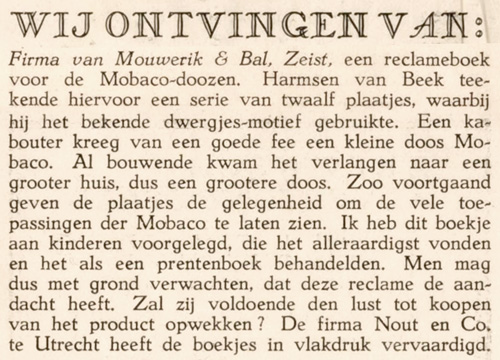 Courtesy of delpher.nl via Leen Kalden This refers to Steendrukkerij Nout & Co, later known as "N.V. Utrechtse Drukkerij voorheen Nout & Co" in Jutfaas, now part of Utrecht. Careful comparison of all Mobaco printing material shows they have similar printing and paper, going back to the oldest examples, and were likely all done by the same printer, Nout & Co. The above clipping is from 1931. In the municipal archives of Utrecht (Het Utrechts Archief), we found two bookkeeping ledgers from Nout & Co, one for 1936 and one for 1942/43, and both have entries for Moubal, confirming Nout & Co continued printing for them until at least April 1942 (there are no invoices in that ledger for Moubal for the remainder of 1942, nor in 1943). In conclusion, it appears that brochures, manuals and price lists were all printed by Nout & Co, starting in 1924 until at least April 1942. There are several items printed during the second world war by Drukkerij van Lonkhuyzen in Zeist. We know this because those items are identified with K2607, a "K-number" required by the occupier. Van Lonkhuyzen also printed the ELBA Set B manuals, and probably other things for Moubal, since they were nearby. There is also a price list printed during the war by K1795, which refers to Drukkerij Verweij in Mijdrecht. MOUBAL MOBACO PRICE LISTS + ADVERTISEMENTS WITH PRICES Below, in chronological order, everything found so far that sheds light on pricing and chronology of sets, starting with the very first ad listing Mobaco prices. After all the price lists, there is a collection of Mobaco ads with prices that don't provide "new" information, but are fun to browse and are included for reference. 25 November 1924 - Advertisement in Nieuwsblad van het Noorden This is the earliest known dated reference with set prices, and is only a month after the oldest known Mobaco advertisement (18 October 1924). Prices are fl. 5.50 for Set 1 and fl. 12.00 for Set 2. These prices wouldn't change for a decade. These same prices are shown on the 1924 Display Card. The text in the ad translates as: MOBACO, Construction sets for houses. Completely new, beautifully made, very sturdy colored parts, fitting perfectly, no. 1 ƒ5.50, no. 2 ƒ 12.–. Dutch manufacture. Catalog on request. Only available at Het Kinderparadijs (The Children's Paradise). Het Kinderparadijs had a store in Groningen and in Leeuwarden, both in the north of The Netherlands. Even though the ad states "Only available at Het Kinderparadijs", Mobaco was simultaneously available in other towns, including in Apeldoorn and in Zeist, and even in Batavia (Dutch East Indies).  Scan courtesy Henri de Graaf 27 November 1925 - Advertisement in De Harderwijker This is the earliest known reference to Sets 0 and 1a, which were introduced only a year after Sets 1 and 2 were first introduced. This ad mentions that loose parts are available. So starting in 1925 (and perhaps earlier), loose parts were available, but it's not until 1932 that price lists have prices for spare parts.  Scan courtesy Leen Kalden Undated #7 (English) - 1925? This is the first in a series of Mobaco price lists with a colorful illustration on the front, and information on the back. Interestingly, it is in English! Presumably there is also a similar Dutch version. Technically, this is not a price list, as prices are not shown, but because of the format I include it here with the other price lists. Based on the sets listed, 0, 1, 1a en 2, this document must be from 1925, same year as the advertisement above. The oldest known British ad also dates from 1925. Like in Undated #1 (see below), listed are parts count, number of models and weight of sets, except no prices are listed. Interestingly, the part count of Set 0 is overwritten in ink, probably by the factory. The printed number is 88 parts, handwritten is 108 parts, and ultimately this set will have 111 parts, indicating that they were still finalizing the contents of Set 0 when this list went to print. Weights will still change a bit, first in Undated #1, then again in Undated #2, after which they won't change anymore. The back has a simple art deco border. In Undated #9 and Undated #1 (±1926), this is changed to a more elaborate art deco border, which will remain unchanged until 1941. Artwork is done by the same person who created the village illustration on the cover of the 1924 manuals. Top left and top right are drawings of Train Station Set No. 1, which won't come out until 1926. The manual of Train Station #1 uses the exact same drawings. Bottom left is Model #18 of the Set 1 manual, and bottom right is Model #23, also from the Set 1 manual. These exact same illustrations are used as stickers on early boxes.   Scans courtesy Leen Kalden Undated #9 (English - UK) - 1925? This price list is from the United Kingdom. The cover image is identical to this poster. It is full of perspective errors, and probably drawn by a different person from Undated #7 above. Weights are now indicated in pounds instead of kilograms, and prices are shown in shillings/pence. DATING The list now correctly identifies Set 0 as having 111 parts. This indicates it came after Undated #1 above, but before the ad below which references Sets 00 and 4. This list is likely from 1925. PRICE COMPARISON Since there are 12 pence in a shilling and 20 shillings in a pound, and the exchange rate in 1925 was fl. 12.01 per pound, the cost of these sets was: Box 0: 6/9 = £ 0.3375 = fl. 4.05 (versus fl. 3.25 in Holland) Box 1: 11/6 = £ 0.5750 = fl. 6.91 (versus fl. 5.50 in Holland) Box 2: 25/- = £ 1.2500 = fl. 15.01 (versus fl 12.00 in Holland) Box 1a: 14/6 = £ 0.7250 = fl 8.71 (versus fl. 8.25 in Holland) So Sets 0, 1 and 2 were 25% more expensive in the UK, while Set 1a was only 5.5% higher. In Holland, Set 1a was overpriced relative to the number of parts in the set. In the UK, the price for this set made more sense in relation to the other three sets! By comparison, at the time a Meccano No. 3 set cost 22/6 in the UK, comparable to a Mobaco Set 2. The Mobaco set had a lot more parts!  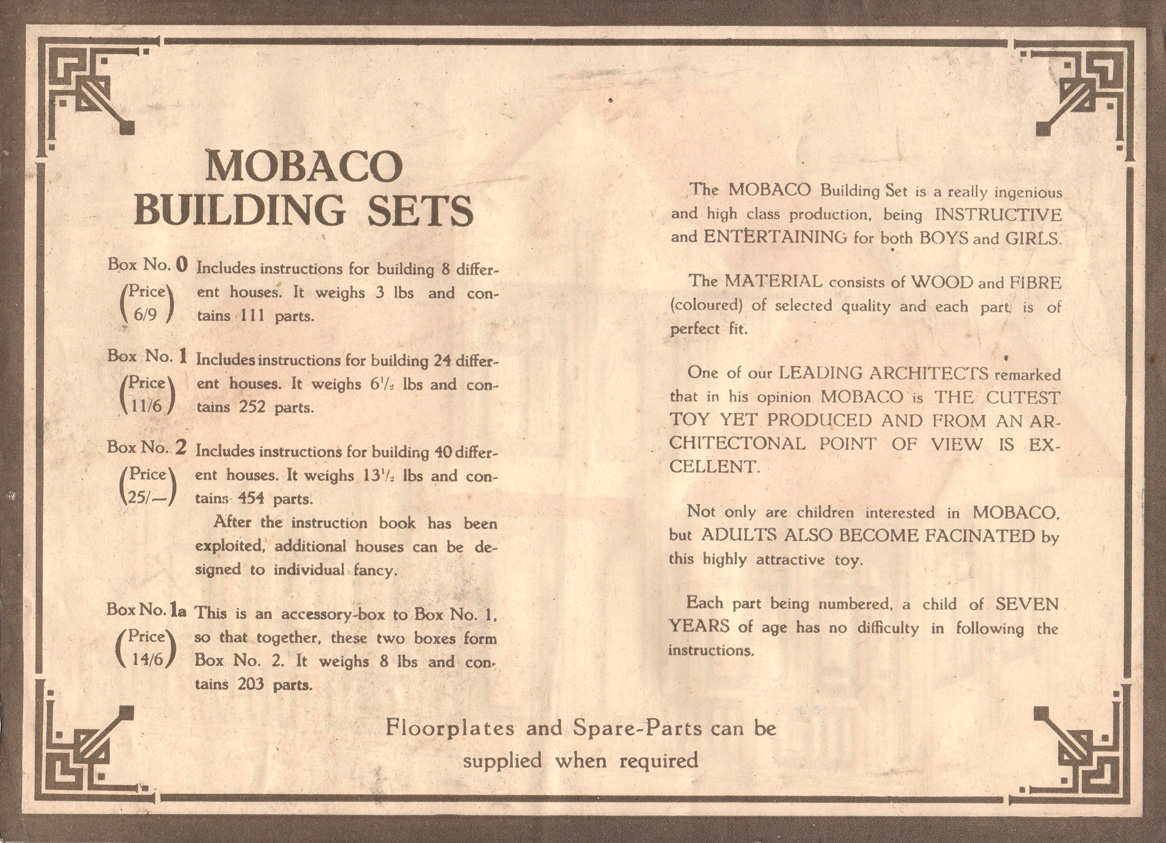 Scans courtesy Leen Kalden 13 November 1926 - Advertisement in Schilder's Nieuws- en advertentieblad This is the earliest known reference to Set 00 and Set 4, which retailed for fl. 2.00 and 52.50 respectively.  Scan courtesy Leen Kalden 20 November 1926 - Het Kind, veertiendaagsch blad voor ouders en opvoeders The right item is a correction issued on 4 December 1926 on a piece written on 20 November 1926 (left item). Since it's a correction, I use the date of the original item. This shows that in addition to Set 1 (252 parts, fl. 5.50), Set 2 (454 parts, fl. 12.-), Set 00 (fl. 2.-) and Set 4 (fl 52.50), Station 1 (fl. 5.-) and Station 2 (fl. 9.50) were now available. Loose parts were fl. 0.05. The ground plate for Set 1 was fl. 0.30 and for Set 2 was fl. 0.40. It mentions there is a "prospectus" available, probably referring to Undated #2 below. So in the fall of 1926, Mobaco was selling Sets 00, 0, 1, 1a, 2, 3, 4, Station 1 and Station 2. Bosch Honig & Co in Utrecht is listed as the sole representative for The Netherlands. 
 Images courtesy of Leen Kalden Job Denijs price lists - overview There are three versions of this illustration. At first blush, they all look the same, but careful analysis shows several changes. Here a comparison of known versions: 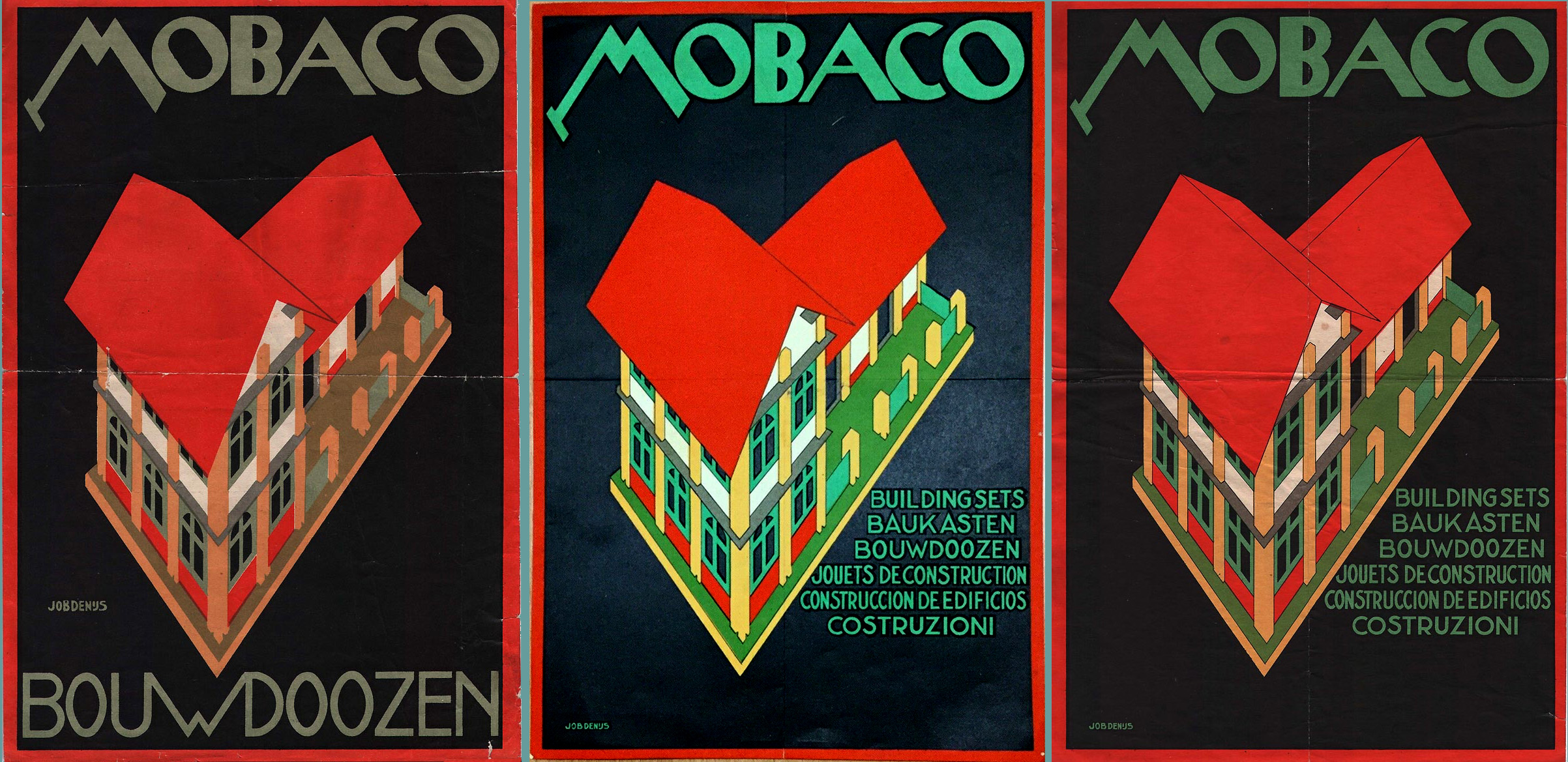 Left has round windows, a brown base plate and large text. So far the text has been found in three languages: BOUWDOOZEN (Dutch), JOUET DE CONSTRUCTION (French) and CONSTRUCCION DE EDIFICIOS (Spanish). The color of the base plate is achieved by overprinting the color of the columns and the windows. In the left version, this results in a brownish base plate, in the middle and right versions it results in a green base plate. The letters MOBACO are the same color as the windows. In the middle version (Undated #13 below), the colors are different, there are black lines around the columns and the parts, the illustrator's name has been relocated and made smaller, and the large text has been replaced by smaller text in 6 languages: English, German, Dutch, French (now plural, JOUETS), Spanish, Italian. This suggests Mobaco may have been sold in all those language regions, but so far it appears it wasn't actually sold in all of them. In the right version, the windows are now square, there are black lines along the roof ridges, and the suggestion of grooves in the columns have been removed. Undated #1 - Version 1 (early 1926) & Version 2 (late 1926) This is the first in a new series of Mobaco price lists with the colorful illustration by artist Job Denijs. Listed are parts count, number of models, weight of sets and sets prices, but no prices for individual parts. There are two versions of this list: Version 1 without any prices, and Version 2 with overprinted prices and several new sets. DATING Since Set 1 is listed as 252 parts and Set 1a as 203 parts, this price list must be before September 1936, when the contents of Sets 1 and 1a changed. The overprint in Version 2 also lists Sets 3, 4 and Stations No. 1 & No. 2, which suggests these sets were newly introduced, and would place this version of price list after Undated #7 and Undated #9 above, and before Undated #2 below. Set 3 is listed as having 882 parts, and Set 4 as 1137 parts, while all later lists have them as 880 and 1135 parts respectively. This suggests that Moubal were still in the process of finalizing those sets when this was printed. Set 00 and Set 4 are not yet a mentioned in the 1925 ad above, but are found in an advertisement in "Schilder's Nieuws- en advertentieblad" from 13 November 1926, also above. This suggests that Sets 00, Set 3, Set 4 and both Stations were introduced in 1926. And since Set 00 is printed "in the background" in the price list below, it was already available before Set 4. Set 00 is not yet mentioned in the 1925 ad, so must have been introduced later, but before Set 4. This would put the introduction of Set 00 early in 1926 and the introduction of Sets 3, 4, Station No. 1 and No. 2 late in 1926. So the overprinting in the price list below is from late 1926, with the original printing from early 1926. The text mentions that sales in the Netherlands are exclusively through N.V. Bosch Honig & Co in Utrecht. None of the later price lists mentions this. Undated #1 - Version 1 (probably early 1926):  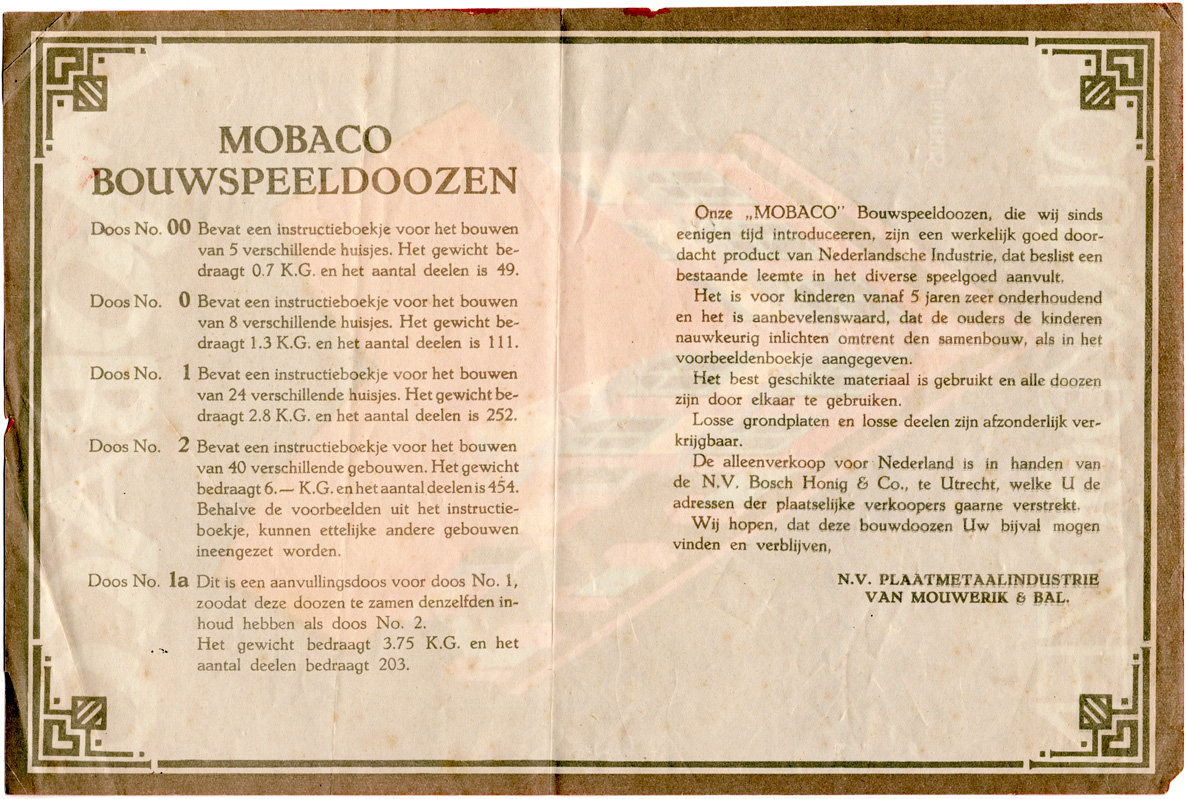 Original courtesy Nick Cranendonk Undated #1 - Version 2, with overprint (probably late 1926):   Original courtesy Nick Cranendonk Undated #2 - 1927? Colors of the front image are the same as in Undated #1. This price list only has set prices, number of parts and weight. No parts prices. It lists Sets 00, 0, 1, 1a, 2, 3, 4, Station 1, Station 2. On the back, the name Mobaco is printed in regular font, not yet the logo with the funny O's. The border is a simple fat line, and is different from all other price lists except Undated #6. The narrative mentions the use of Mobaco in schools. Strangely, the narrative begins on the right side, then continues on the left side. So this may be a printer error. DATING Set 1 has 252 parts and Set 1a has 203 parts, so this price list must be before September 1936. And it must be after Undated #1 which was probably from 1926. Also, it does not yet list Set 000, which was shown in an advertisement in de Telegraaf in 1932 (see below), and does not list Set 2a which must have come out by 1931. This puts this price list somewhere between 1927 and 1930.  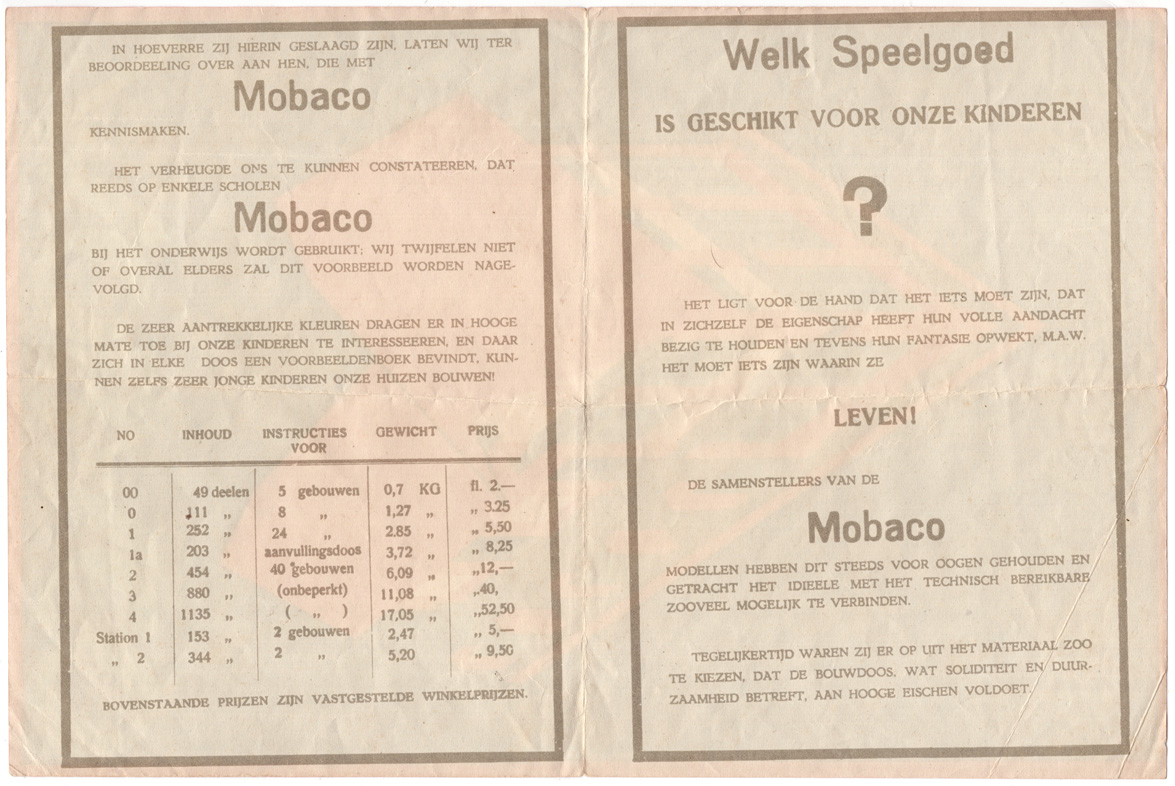 Scans courtesy Leen Kalden Undated #6 - 1928? Very similar to Undated #2 above, except the text columns have been swapped, with the sets list now on the right. This new arrangement is used in all future price lists, starting with Undated #3 below. So this price list probably came after Undated #2 above, and before Undated #3 below. But we don't know from when Undated #3 is, so all we can say about this price list is that it's from somewhere between 1927 and 1930. 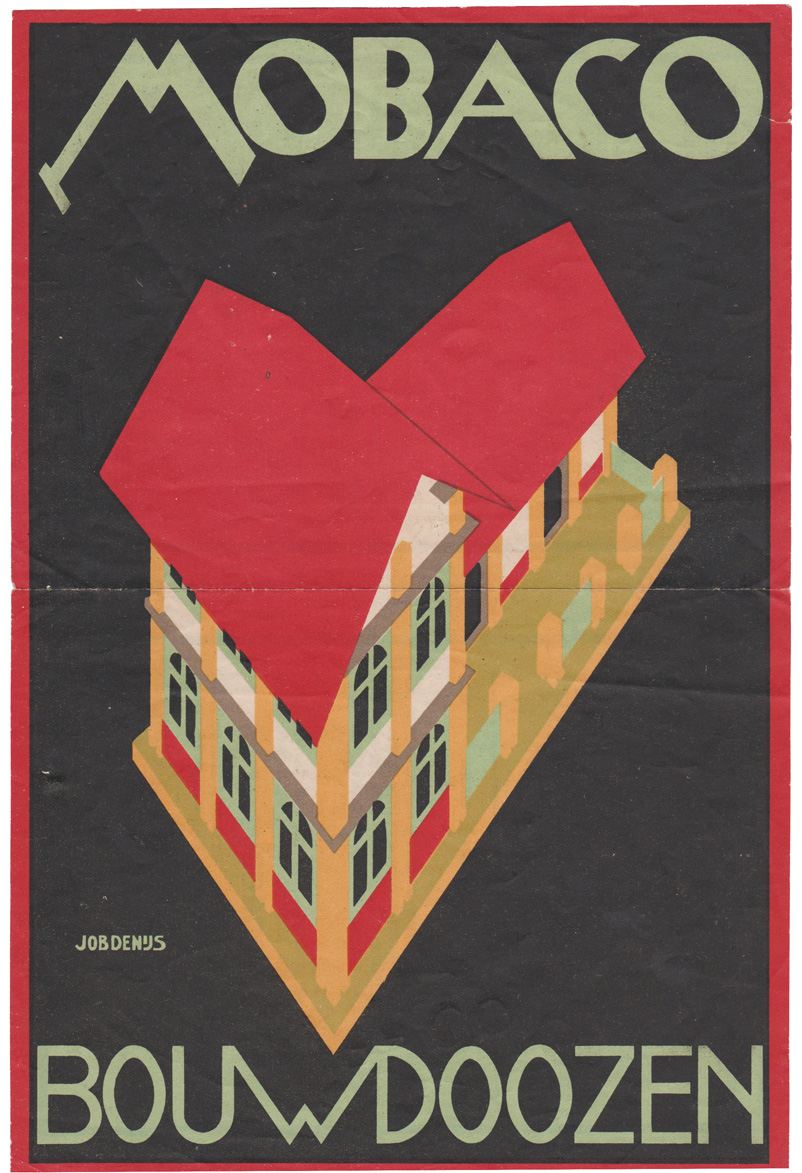  Scans courtesy Leen Kalden Version with overprint from a store in Rotterdam:  Original courtesy of Nick Cranendonk Undated #3 - 1929? The illustration of this undated Mobaco price list is the same as Undated #6 above, but different from the illustration in Undated #4 below. On the back, the simple rectangular borders have been replaced with an art deco border, similar to Undated #1. This border will be used in all future price lists. The layout of this price list puts it between Undated #6 above and Undated #4 below. The narrative also mentions the use of Mobaco in schools. DATING Set 1 has 252 parts and Set 1a has 203 parts, so this price list must be before September 1936. And it must be after Undated #1 which was probably from 1926. Also, it does not yet list Set 000, which was shown in an advertisement in de Telegraaf in 1932 (see below). And it does not yet show Set 2a, which came out in 1931 or before. This puts this price list somewhere between 1927 and 1930.   Scans courtesy Leen Kalden There is an unpriced version of this Price List:  Scan courtesy Matthia Keyes, USA September 1928 - Advertisement in Officieel orgaan van de joodsche invalide This 1928 ad features the same 9 sets as Undated #1 (with overprint), Undated #2, Undated #6 and Undated #3 shown above. In the chronology, it could fit between any of them. This identical ad appeared from 1928-09 through 1929-01, and again from 1929-08 through 1930-02. The ad states that 9 sets are available, and Set 2a is not on the list. This indicates that Set 2a did not yet exist in the fall of 1929. Set 2a was introduced before Set 000, so it must have been introduced in 1930 or 1931. All known examples of Set 2a have square windows and the cursive logo on the box, so Set 2a was likely introduced in 1931.  Scan courtesy of Leen Kalden 12 December 1930 - Ad in Sevenoaks Chronicle and Kentish Advertiser This United Kingdom ad features the earliest example of the "roundish" Mobaco logo. This logo later appears on many price lists, and is used by Jumbo as the logo for their post-war Mobaco sets. The earliest known UK ad for Mobaco is from November 1925, just one year after introduction in the Netherlands. UK Mobaco ads are found in the British Newspaper Archive through December 1932, and nothing after that. Perhaps Moubal stopped exporting to the UK after 1932? Prices for Sets 0, 1 and 2 are the same as in Undated Price List #9 above, which is likely from 1925. In 1930, the exchange rate for the UK pound was appr. £1 = fl. 12, so these sets cost appr. fl. 2.40, 4.05, 6.90 and 15.00. In 1930, the Dutch prices for Sets 00, 0, 1 and 2 were 2.00, 3.25, 5.50 and 12.00, so the UK prices were about 25% higher, same as in 1925.  Ad courtesy of Leen Kalden Undated #8 - French (Switzerland) - 1931? This is a French-language Price List. Prices have been covered in black, but you can still read them, except for Set 00, but careful study reveals that it was Fcs. 3.75. Prices are about 2.0 to 2.2 times the Dutch prices. The exchange rate between the guilder and the French franc in 1931 was about 1 guilder = 10.3 francs, so these prices can't be for France. In those days the Belgian currency was called the Belga, so can't have been that either. However, in 1930 and 1931, 1 guilder = 2.1 Swiss franks, so this price list was for Switzerland. DATING This price list mentions Set 2a, so must be after the price lists above, but not yet Set 000, so must be before Undated #4 below. Also, the drawing on the front is the same as the ones above, but different from the one below, so this undated price list must be before Undated #4 (and Undated #13). Set 2a came out in 1930-1931, and Set 000 came out in 1932, so this price list must be from 1930-1931. All known Sets 2a have square windows and the cursive Mobaco logo on the lid, which came out in 1931, so Set 2a likely came out in 1931, and this price list is likely from 1931. 
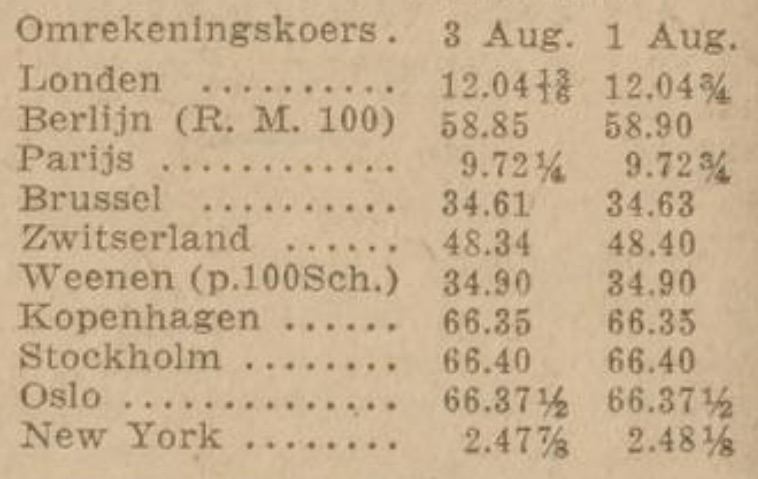  Scans courtesy of Henri de Graaf Undated #14 - Spanish This was found as an illustration in an article about Mobaco. An original is yet to turn up, if you have one, please send me a scan! It looks similar to the French version above, except that the text is CONSTRUCCION DE EDIFICIOS.  Undated #13 - German - 1930 or 1931 This undated price list is in German. Although it doesn't have prices, it's shown here as it's similar to the other Job Denijs price lists. The image is a transition version between all the versions above, and Undated #4 below: windows are still round, but the parts in the image now have black outlines, the illustrator's name has been relocated and made smaller, and the term "Building Sets" on the front is now in 6 languages (English, German, Dutch, French, Spanish and Italian). Interestingly, the translations have slightly different meanings: English: Building Sets German: Construction boxes Dutch: Construction boxes French: Construction toys Spanish: Construction of Buildings Italian: Buildings DATING Set 000 is not listed, so it predates 1932. The revised illustration puts it after the above price lists. One would therefore expect to see Set 2a, which is listed for the first time in the French price list above (Undated #8). The revised illustration suggests that this German version came out in 1931, shortly after set 2a was introduced, but they didn't list it by mistake. Alternatively, the French price list above was printed on the back of leftover older illustrations, in which case this price list dates from 1930. 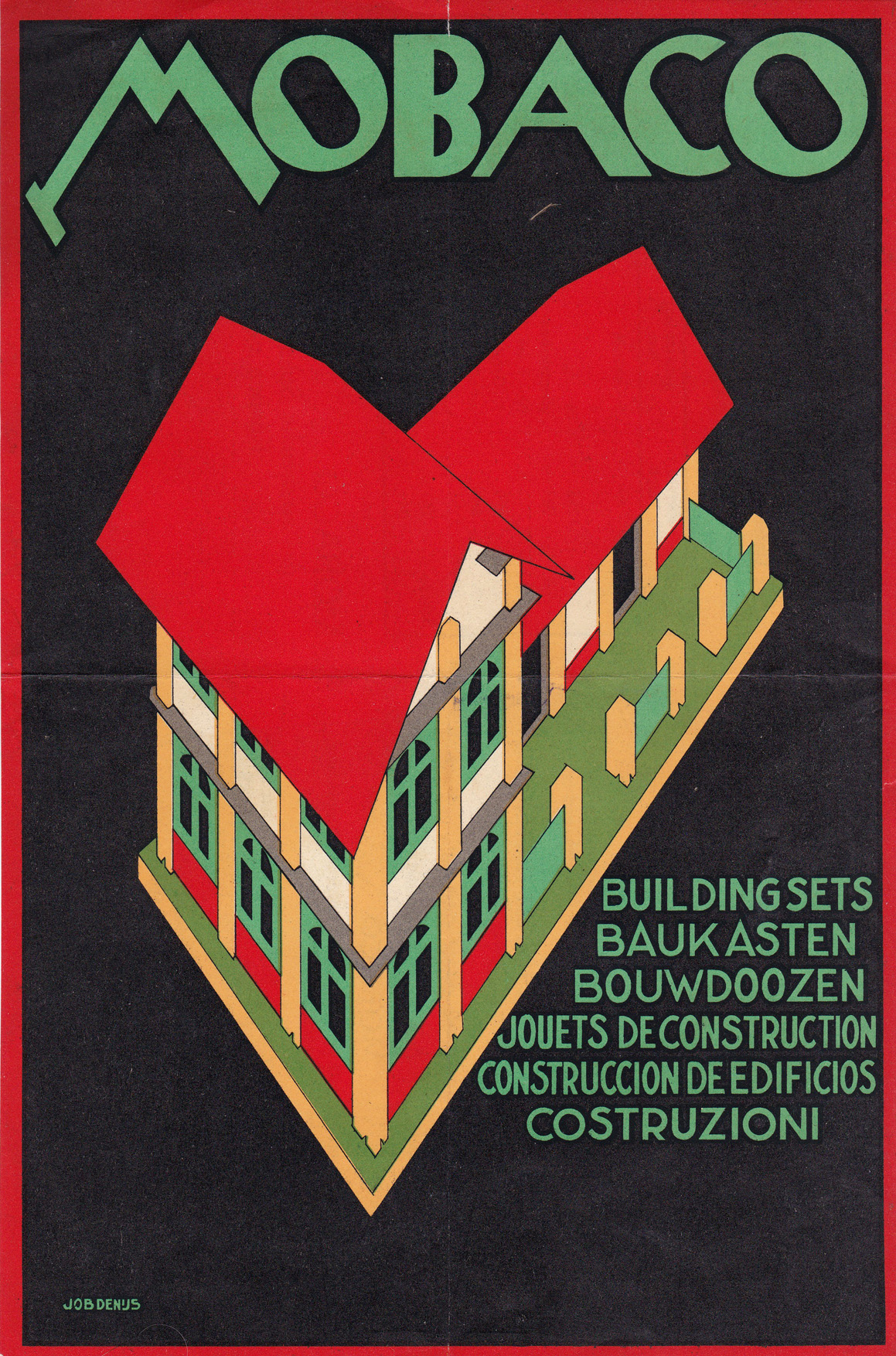 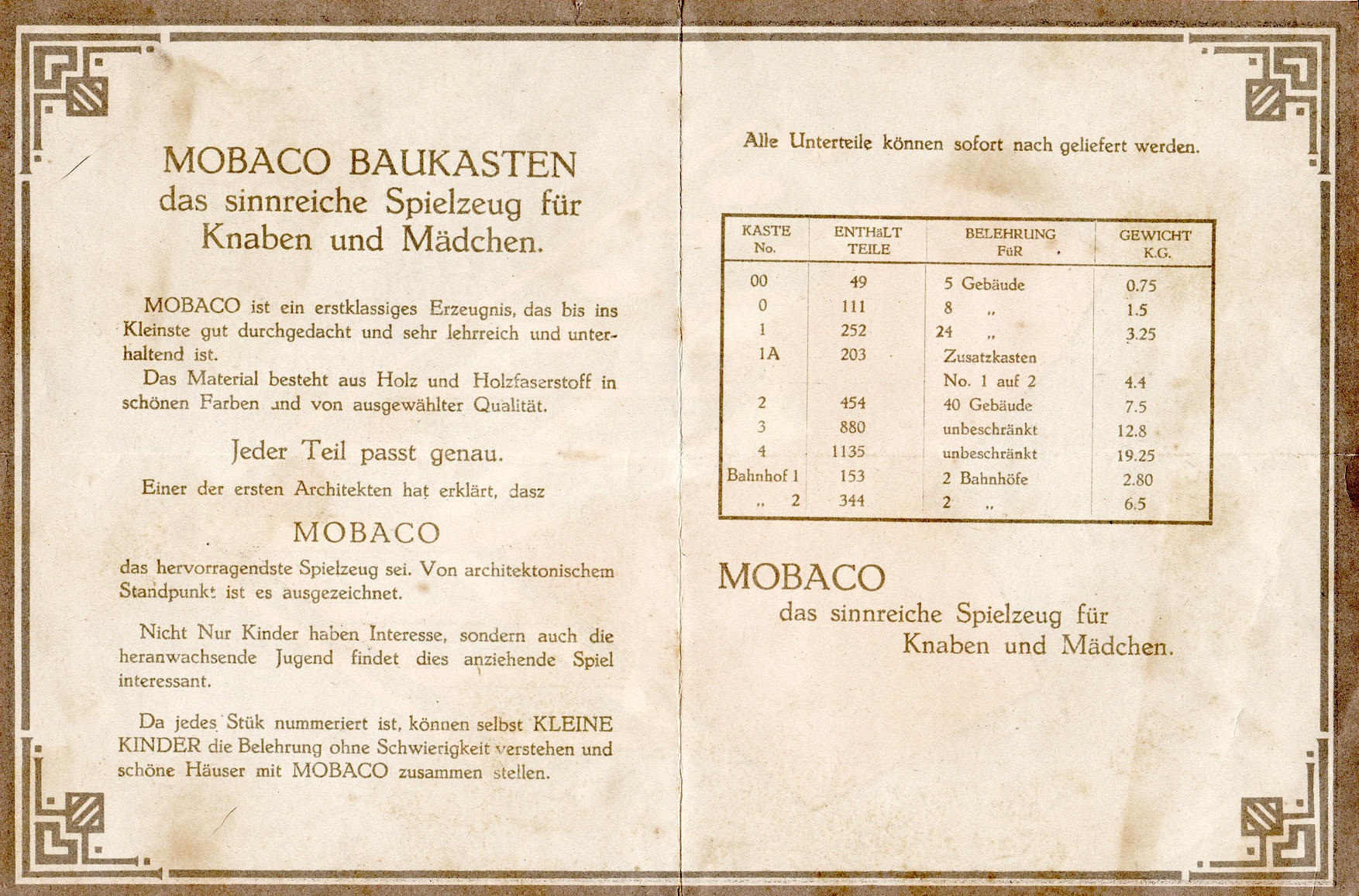 Images courtesy of Leen Kalden Undated #15 - 1931? The illustration on this undated price list is the same as on the German Undated #13 price list above, with round windows and simplified black outlines. The text on the back is the same as in Undated #4 below. The font is still traditional. Undated #4 further below and all the next price lists have a modern sans-serif font. There are two versions of this price list, with and without prices. DATING Prices are still the same as in 1926. Listed is set 2a, which places it after Undated #13 above. But it does not yet mention Set 000, so it must be before the advertisement in De Telegraaf below from 21 November 1932. Set 2a came out in 1930-1931. All known Sets 2a have square windows and the cursive Mobaco logo on the lid, which came out in 1931, so Set 2a likely came out in 1931, and this price list is likely from 1931. VERSION 1 - WITH SET PRICES: 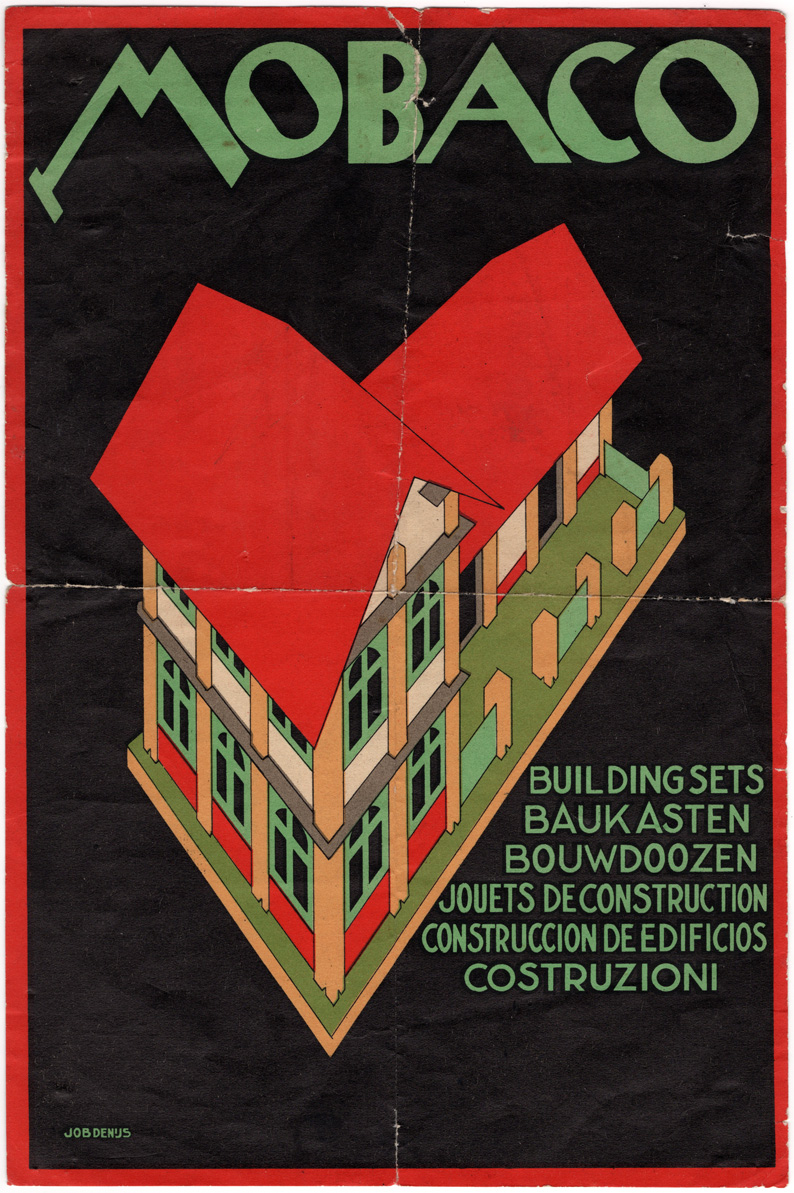 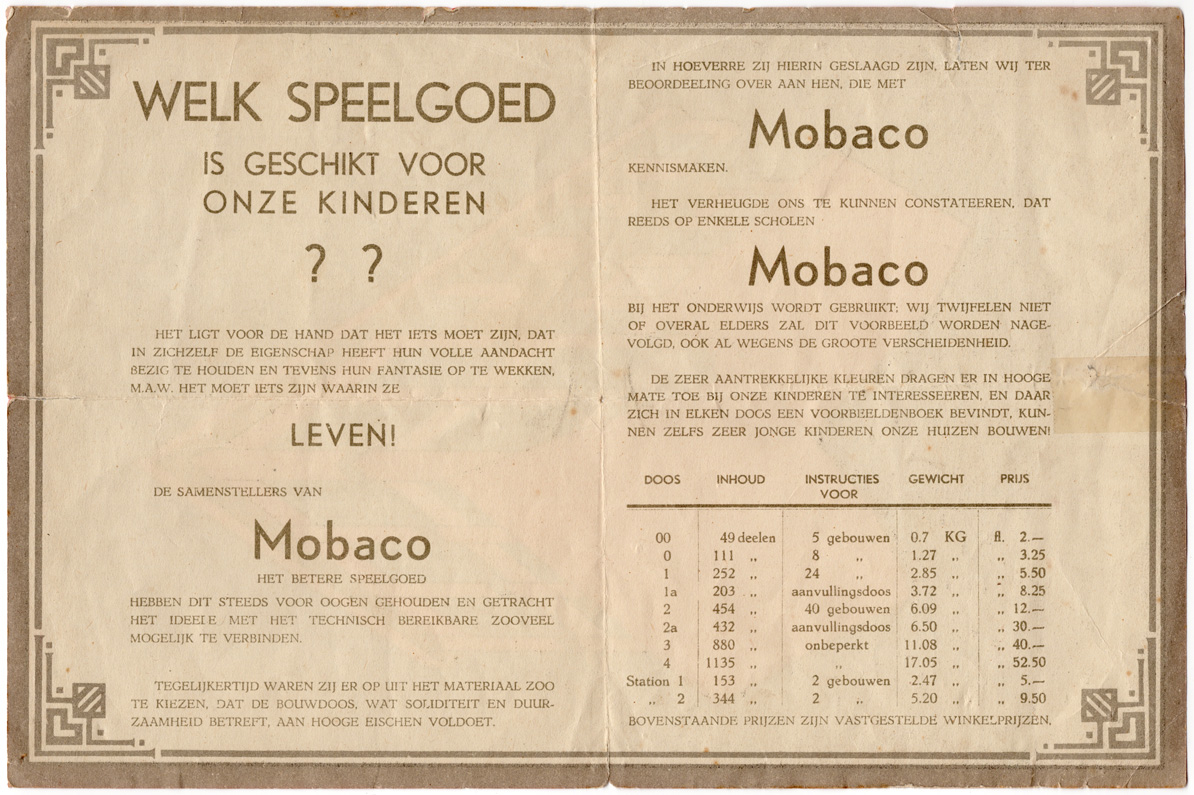 Original courtesy of Nick Cranendonk VERSION 2 - WITHOUT SET PRICES: 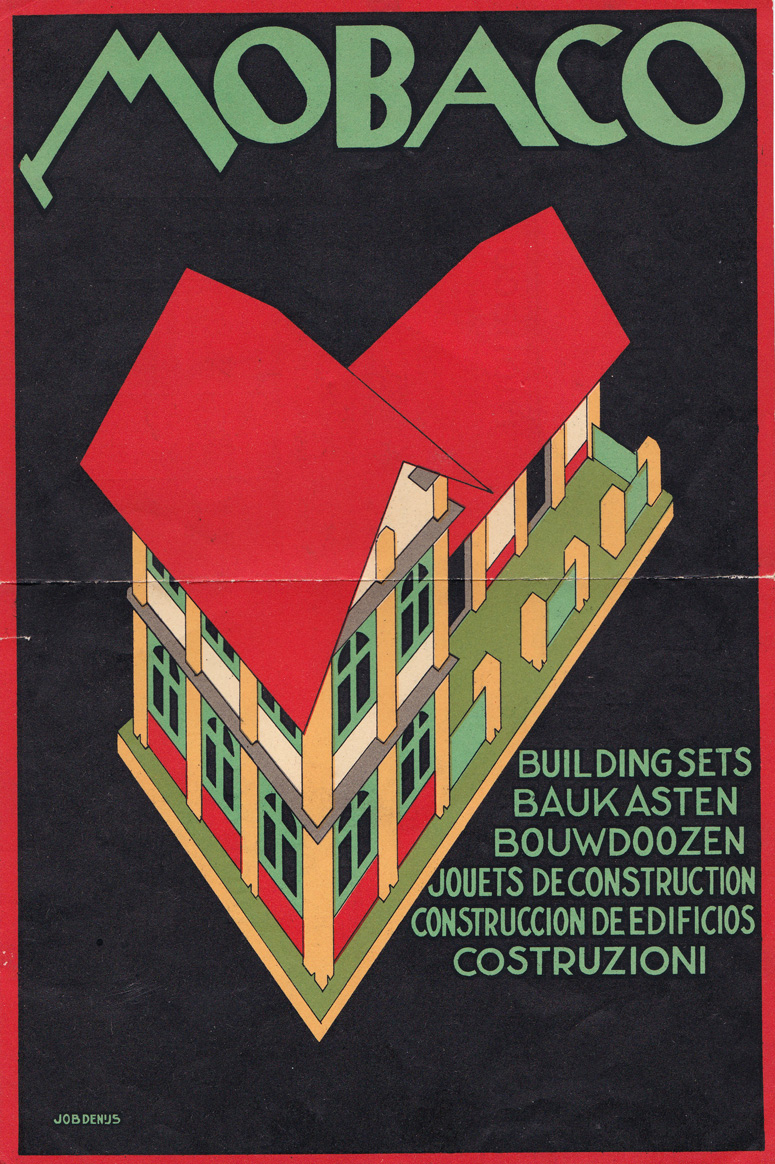  Scans courtesy of Leen Kalden Undated #16 - English (United Kingdom) - 1931? This is an undated English-language price list with weights in pounds but without prices. The illustration on this price list is the same as on Undated #15 price list above, with round windows and simplified black outlines. The font is still traditional, while Undated #4 below and all the next price lists have a modern sans-serif font. DATING Listed is set 2a, which places it after Undated #13 above. But it does not yet mention Set 000, so it must be before the advertisement in De Telegraaf below from 21 November 1932. Not listed are the Train Station sets. Set 2a came out in 1930-1931. All known Sets 2a have square windows and the cursive Mobaco logo on the lid, which came out in 1931, so Set 2a likely came out in 1931, and this price list is likely from 1931. 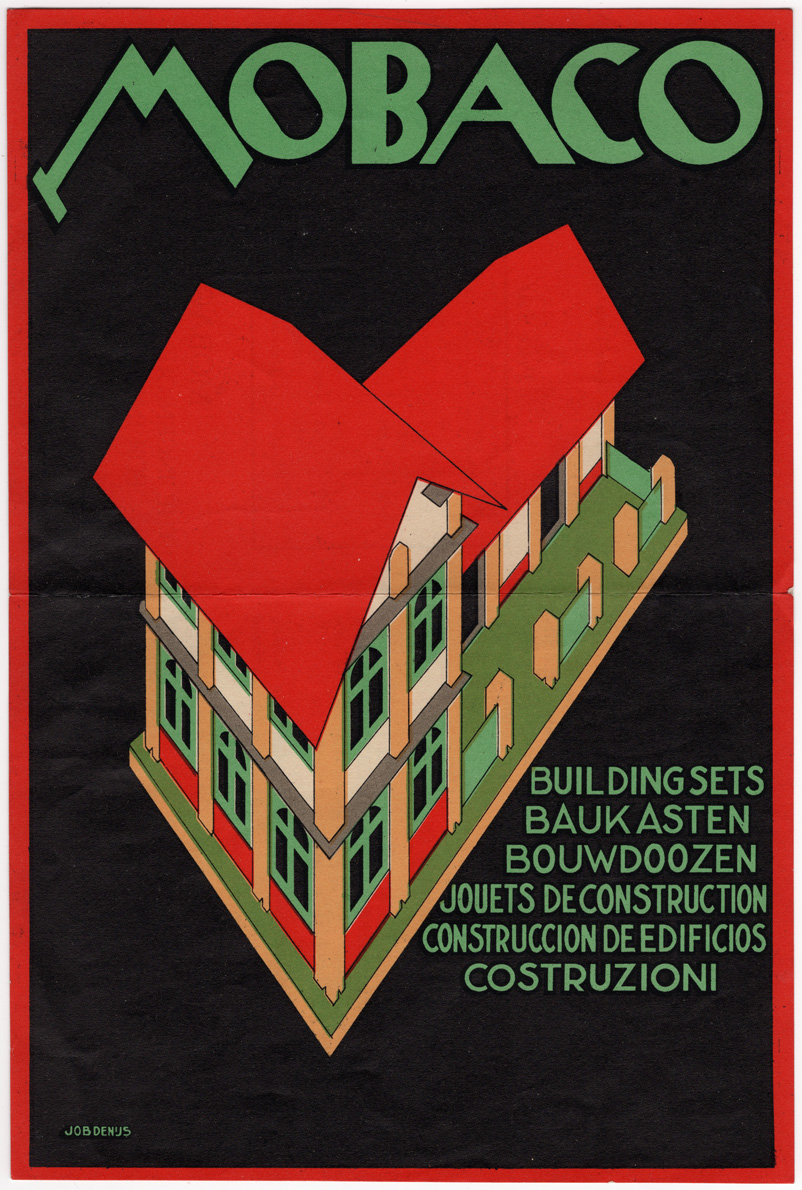  Original courtesy of Nick Cranendonk 1931 Thorngreen Toy Catalog, Denmark So far this is the only Danish advertisement we found. Translation: NEW BUILDING MATERIALThe prices suggests that they advertised sets 00, 0 and 1, which at the time cost in Holland fl. 2.00, 3.25 and 5.50. The same illustration was used in ads in the Dutch magazine "De vrouw en haar huis" starting in April 1930. The building features a part that doesn't exist, the slotted window in the top:   Scan courtesy of Barend Westerveld Theodor Thorngreen was a well known toy store in Copenhagen. The building still exists, but the store now houses a pharmacy:  Scan courtesy of Københavns Museum, foto by Frederik Riise, undated 21 November 1932 - advertisement in De Telegraaf This is the first advertisement featuring Set 000. Prices are identical to Undated #4 below. So by 1932, Set 000 existed. There are lots of ads in 1932 that mention Set 000, while not a single one in 1931, so it's very likely that Set 000 is from 1932. The ad mentions 11 sets, which is the same number of sets as in Undated #4, and which includes Set 2a.  Scan courtesy of Leen Kalden Undated #4 - 1932 This illustration is very similar to Untitled #1, #2 and #3, except the windows are changed from round to square, the grooves in the columns are no longer shown and the roof ridges have a black line. This is the first price list with prices of individual parts. The prices of parts are identical to the August 1934 price list (see below). This is also the first price list showing manuals: - a manual for Set 000 costs fl. 0.10 - a manual for Garages No. 1 and No. 2 costs fl 0.10 - a manual for Sets 00-0-1 costs fl. 0.40. This is the Set 00-0-1 gnomes manual - a manual for Sets 1, 1a, 2, 2a, 3 and 4 costs fl. 1.10. This is the Set 1 - 4 gnomes manual This is the last price list with the image by artist Job Denijs. DATING Set 000 appears for the first time. Set 000 is shown in many ads in 1932 (see previous), and none in 1931, so this price list must be from 1932 or later. However, the price of Set 000 is shown as fl. 1.25, and in 1933 the price dropped to fl. 0.95 (see ad below), so this price list is from 1932. There are two versions of this price list, the only difference being that in the second one, the set prices are blank (but parts prices are shown). VERSION 1 - WITH SET PRICES:   Scans courtesy of Nick Cranendonk VERSION 2 - WITHOUT SET PRICES (UNDATED #10):   Scans courtesy of Henri de Graaf 25 November 1933 - advertisement in De Tijd This ad shows that Set 000 dropped in price from fl. 1.25 to fl 0.95 in 1933. The other sets however did not change in price. This helps date the Price List Undated #11 (see next). Note that the image is identical to the cover of the 3rd version of the Gnomes Manual which is probably from 1933 as well. 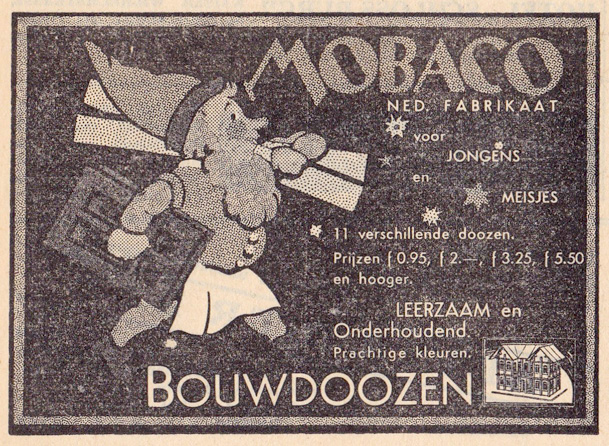 Scan courtesy of Leen Kalden Undated #11 (1933) A new drawing by artist Eelco ten Harmsen van der Beek graces the front of the price list. His initials are below the right foot of the kneeling boy (HvB). The size of the house is out of proportion with the kids! Dating: This price list has the same prices as Undated #4 above (1932), except that Set 000 dropped from fl. 1.25 to fl. 0.95, as shown in the 1933 advertisement above. Prices in 1934 were all lower, so this price list must be from 1933.  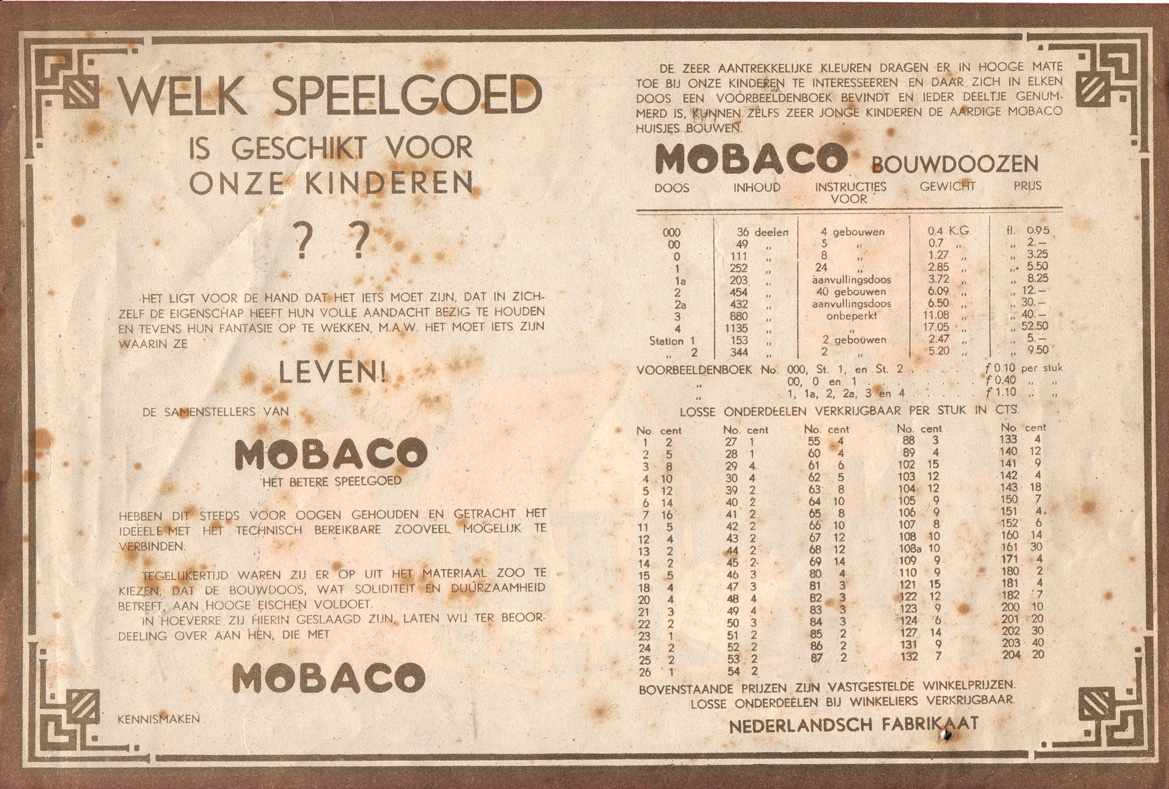 Scans courtesy of Leen Kalden Undated #20 - UK Export Price List (1934) This unusual price list with "Brut Prices" for the UK market accidentally found its way into a consumer set. The marketing text is identical to the 1931 UK price list above, even the line breaks are identical. But everywhere the word Mobaco has been replaced with the logo. Note that there are two versions of the logo, an incorrect version in the text and the correct version under the table. The "Brut" or Gross prices are listed in guilders, and include free railway delivery (within the Netherlands) or F.O.B. Seaport Holland. "Free on Board" means that the buyer pays for all expenses from the seaport onwards, including shipping, handling, duties, etc. Since these are "Brut" prices (in Dutch: "bruto advies prijzen") there was probably a discount to the wholesale purchaser, depending on the size of the order. Interesting is the the mention of van Mouwerik & Bal. All price lists until this one only mention "Nederlandsch Fabrikaat" (= Dutch manufacture). Starting with this price list, all future price lists mention the company name and phone number. This is exactly 10 years after the start of Mobaco. Perhaps there was a contractual issue that prevented Moubal from listing their name until 1934? At the bottom right is mentioned "6th Edition". No idea what that means. Would this be the 6th version of such a UK price list? DATING The "Brut" prices do not match any of the known price lists, so they don't help dating this undated price list. But there are sufficient other clues to date it: - The illustration by Eelco ten Harmsen van der Beek is first used in 1933, so this price list is from 1933 or later. - The number of parts in Set 1 is 252, which changed to 174 in 1936. So the price list must be from before that change (>> so 1933, 1934 or 1935). - Set 0a is not listed. It was issued in October 1936, so the price list precedes that (>> so 1933, 1934 or 1935). - The Train Station sets are shown. Those were last shown in 1935 (>> so 1933, 1934 or 1935). - The Garage sets are not shown. These were issued in 1935 (>> so 1933 or 1934) - The telephone number is 3145. That number was used starting in 1934. Before that they had 3-digit telephone numbers, such as in this 1933 ad (>> so 1934). So the price list must be from 1934. Here a comparison between 1934 Dutch prices and this 1934 UK Brut Price list. The multiplier drops as sets get more expensive, as illustrated in the graph. Except that Set 2A is cheaper in the UK! Based on the curve in the chart, the price of Set 2a should have been fl. 22.50 instead of fl. 18.50: 
   Original courtesy of Ida Gerrits August 1934
There are six known versions of this price list, all shown below. Version 1 is Undated #11 above with an overprint and a date. Versions 2, 3 and 4 only have minor differences, but Versions 5 and 6 are quite different. In Version 1 the company name and a 4-digit telephone number are added to the bottom-left. This is the first time the company name is mentioned on a Dutch price list and the first reference to a 4-digit telephone number. Before this Moubal had a 3-digit phone number (see this Ad). It is possible that Version 2 came out a bit earlier than Version 1 as it does not yet list the company name, and that they decided to re-use left-over 1933 price lists with an overprint after they had already made Version 2. All price lists after this mention the company name and phone number, as well as a date. In Version 4, the company name and telephone number are also mentioned at the bottom-left, plus printed along the right-hand margin is: "Alleenverkoop voor den boekhandel in Nederland - N.V. Kantoorboekhandel Blikman & Sartorius, Amsterdam", meaning: sole sales for bookstores in the Netherlands are through Blikman & Sartorius, Amsterdam. Versions 5 and 6 threw me for a loop. At first blush they look similar to the other three with the same date, but these two are actually quite different, and much more like the 1935 price list. In the right hand column, text was been moved up and down to make room for three new sets, Set 01, Garage 1 and Garage 2, as well as their corresponding manuals. As there was no room left to mention that parts can be ordered individually, they squeezed in narrow hand printed text. In Version 6, this note was rewritten, again by hand, but a bit larger, heavier and moved to the right. That same hand printed text was again used in 1935 and in 1936. In 1937 the mention was removed. Here a comparison:  Versions 5 and 6 pose a quandary: were Set 01, Garage 1 and Garage 2 introduced in 1934, as the date on the price list suggests, or in 1935? Based on advertisements, my conclusion is that these three sets were introduced in 1935: in 1934 advertisements there is no reference to Set 01, Garage 1 or Garage 2, while all 1935 ads refer to at least Set 01, to Garages, or to all three sets. See for instance the beautiful ad further below. So Versions 5 and 6 of this price list must have been printed in the spring or summer of 1935. They should have adjusted the date, but they didn't. AUGUST 1934 - VERSION 1  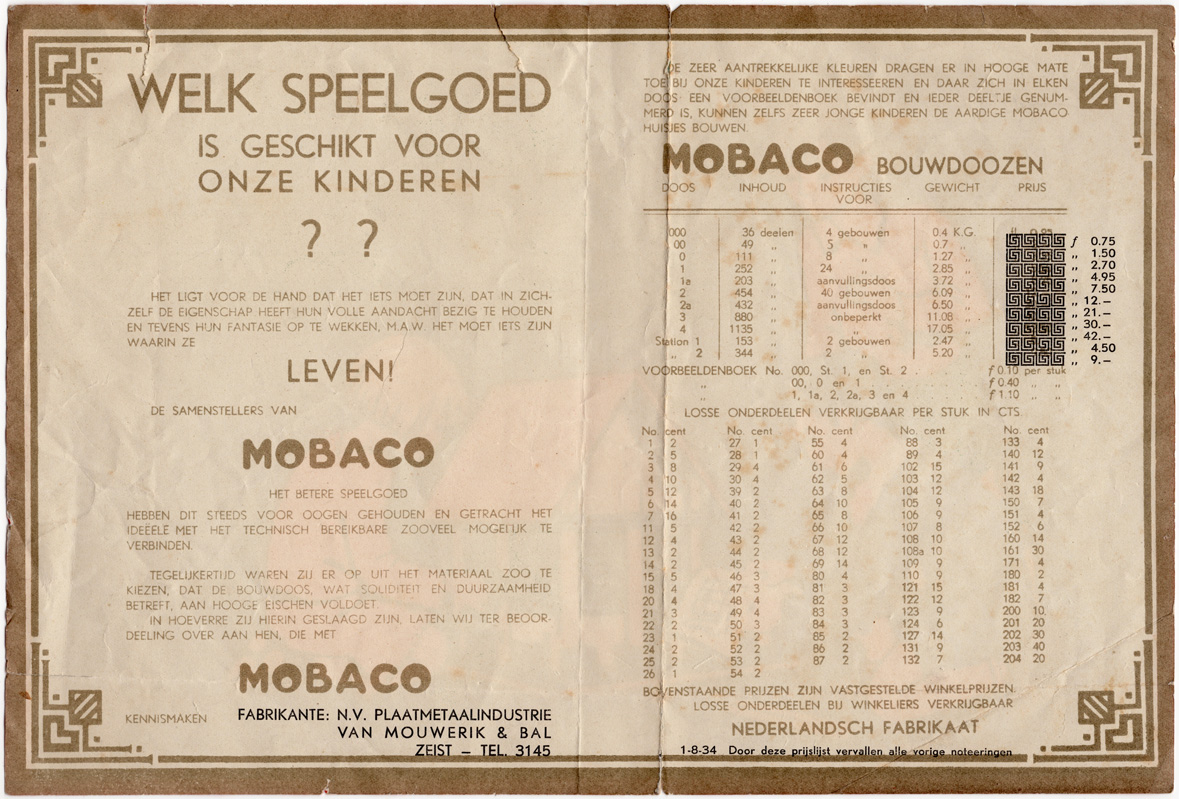 Original courtesy of Nick Cranendonk AUGUST 1934 - VERSION 2  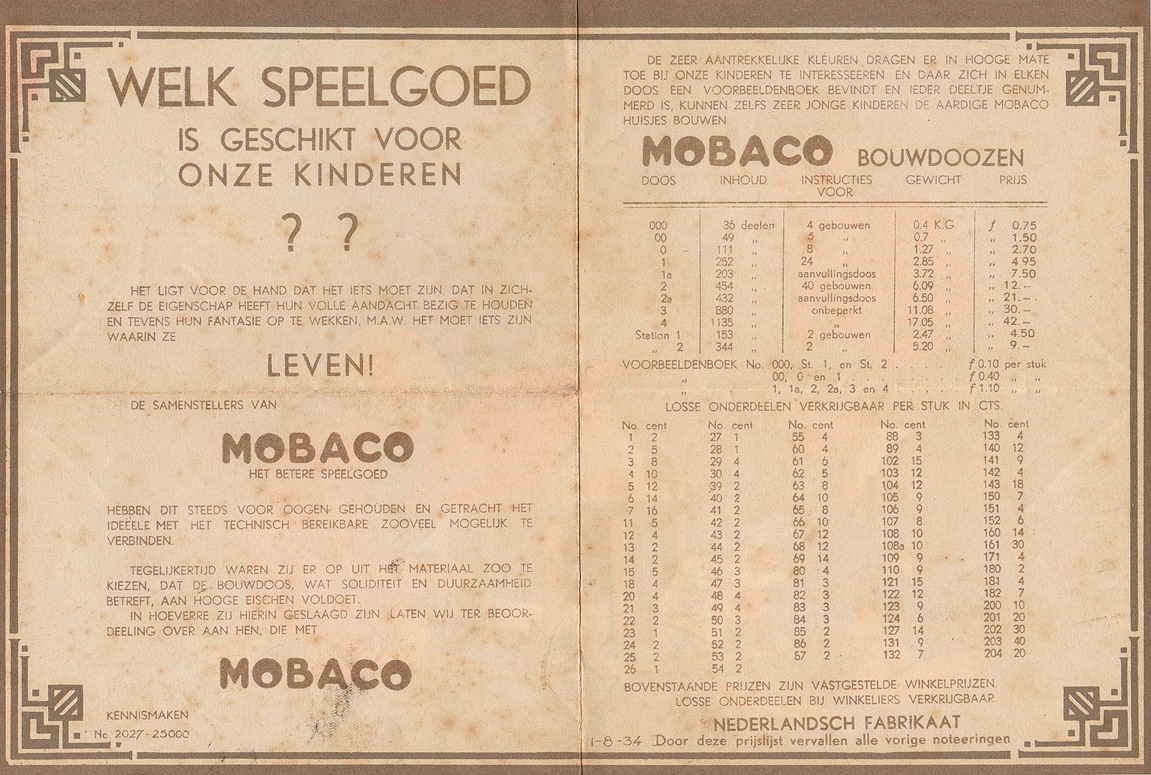 Scans courtesy Leen Kalden AUGUST 1934 - VERSION 3  Back is same as Version 2, except the company name and a 4-digit telephone number are added to the bottom-left. This is the first reference to a 4-digit telephone number, before this Moubal had a 3-digit phone number (see this Ad):  Scans courtesy of Leen Kalden AUGUST 1934 - VERSION 4 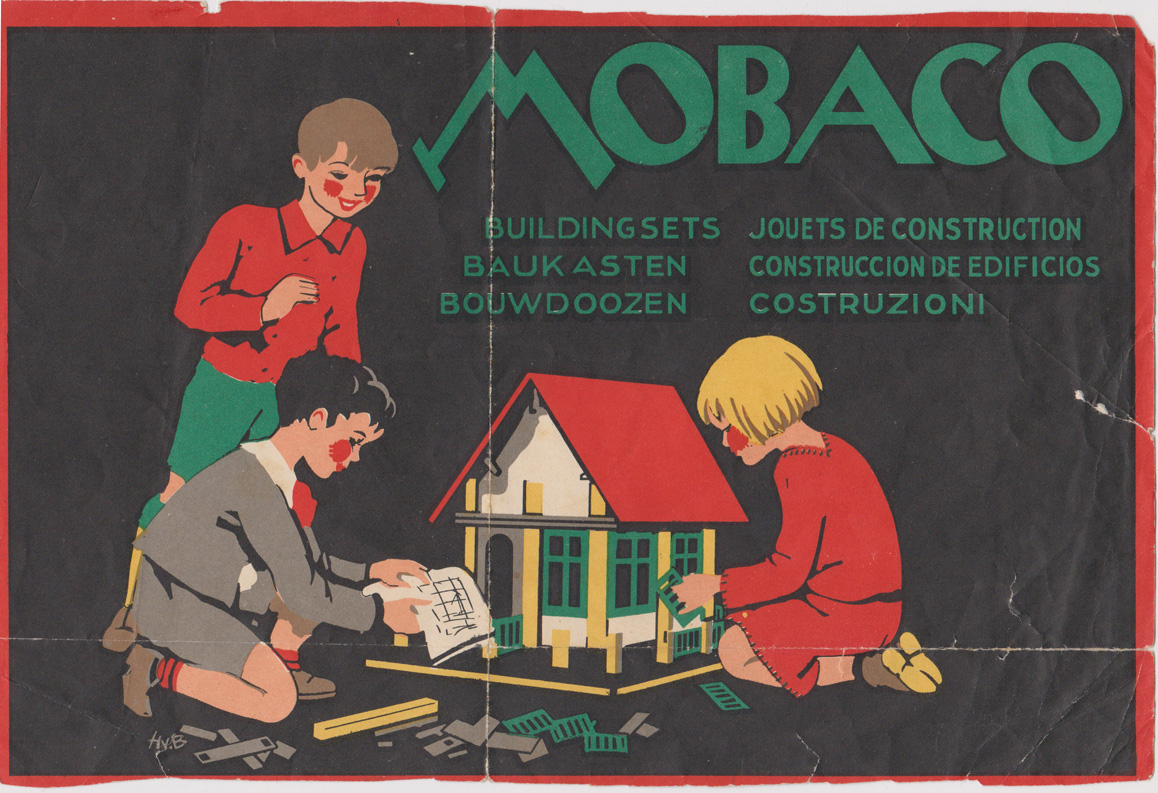 The back is same as Version 3, plus printed along the right-hand margin is: "Alleenverkoop voor den boekhandel in Nederland - N.V. Kantoorboekhandel Blikman & Sartorius, Amsterdam", meaning: sole sales for bookstores in the Netherlands are through Blikman & Sartorius, Amsterdam:  Scans courtesy of Leen Kalden AUGUST 1934 - VERSION 5 (PROBABLY EARLY 1935) On the back, in the right-hand column, text has been moved up and down to make room for three new sets: Set 01, Garage 1 and Garage 2, as well as the corresponding manuals:  Scan courtesy of Tjalling Halbertsma AUGUST 1934 - VERSION 6 (PROBABLY EARLY 1935) The back in this version is identical to Version 5, except that the mention that parts can be ordered individually has been rewritten, again by hand, and the mention of 25000 copies in the bottom-left corner was removed. The printing on this page is exactly the same as the August 1935 price list below. All they did in August 1935 was to change the last digit of the year from a 4 to a 5 (even the 3 wasn't changed!). The price list has a stamp of Boekhandel (= book store) Hillegondia, Bergpoldersplein 9 in Hillegersberg which is near Rotterdam: 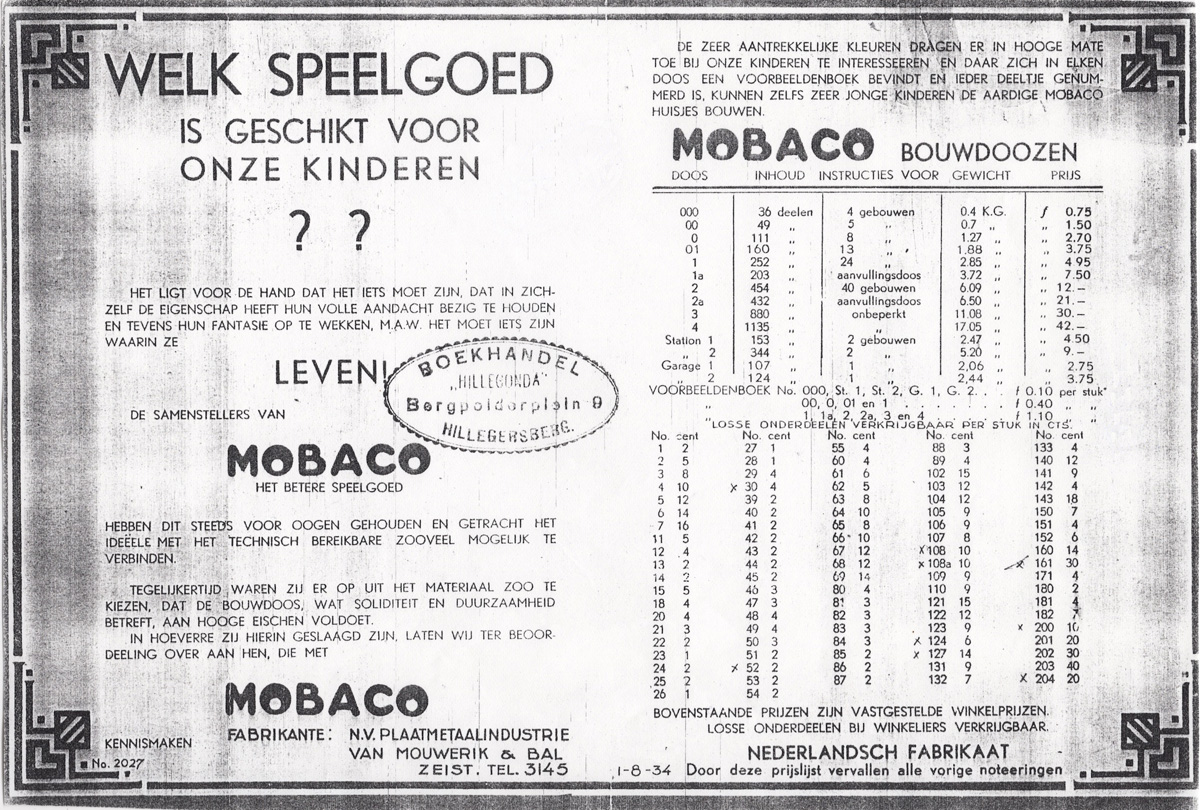 Photocopy courtesy of Nick Cranendonk Undated Leaflet (1935) In some sets, this leaflet was included in the box. It mentions the introduction of Set 01, and Garages No. 1 and No. 2. Set 01 is described as allowing the simultaneous construction of two houses. It actually contains all the parts of Set 00 plus Set 0 (the naming would suggest Set 0 + Set 1!). Garage 1 has a base plate ('fundamentplaat") of 450 x 280 mm, while Garage 2 has a base plate of 450 x 360 mm. DATING Prices are the same as in the August 1935 Price List below (and as in Versions 4 and 5 of the 1934 price list above, which I believe are actually from 1935, see analysis above). Newspaper ads in 1934 do not refer to these new sets, while all ads from 1935 do (see for instance the ad in De Huishoudschool below), which infers that this leaflet is from 1935.   Scans courtesy of Leen Kalden August 1935 This price list is identical to Version 5 of the August 1934 Price List, except the date. All they did was to change the last digit of the year from a 4 to a 5 (even the 3 wasn't changed):   Scans courtesy of Leen Kalden There are three other versions of this price list with a very small difference: the date has been redone. From left to right: enlargement of above price list (courtesy of Leen Kalden), a second version courtesy of Paul Pols, a third version courtesy of Nick Cranendonk and a fourth version courtesy of Barend Westerveld:  Undated #17 - French (Belgium) - 1935  Based
on the prices and the exchange rate, this
French-language price list must be from Belgium
(Wallonia, the French-speaking part of Belgium). Based
on the prices and the exchange rate, this
French-language price list must be from Belgium
(Wallonia, the French-speaking part of Belgium). In 1935, the conversion rate was 18.38 Belgian franks for 1 Dutch guilder, so prices were about 29% higher than in the Netherlands, see table. I also checked if this could be a Swiss or French price list, but it's not. There must have been a transcription error for the price of Set 2a: at frs. 308 is was cheaper than in the Netherlands. I think the price should have been frs. 408 which would bring it more or less in line with the other sets. I used the corrected price when calculating averages. A note at the bottom states that this price list supersedes earlier versions, which suggests there must be earlier price lists for Belgium. DATING This price list features Sets 01 and the Garage sets which were introduced in 1935. In 1936, the Dutch price lists mention that the Train Station and Garage sets are sold until stock runs out, which this price list does not, so this Belgian price list must be from 1935.   Original courtesy of Nick Cranendonk Undated #18 - Dutch (Belgium) - 1935 This undated Dutch-language price list is for Flanders, the Flemish-speaking part of Belgium. Flemish and Dutch are pretty much the same, so Moubal used the same text as on price lists for The Netherlands. Note however that in this price list the text "Losse onderdeelen etc." under the manual prices is type set, unlike the other Dutch price lists that mention the Garage sets. That makes this version different from the others. Perhaps one day this version will surface with Dutch prices? Prices are the same as on the French-language version above (for Wallonia). For Dating, see notes for the French version above. 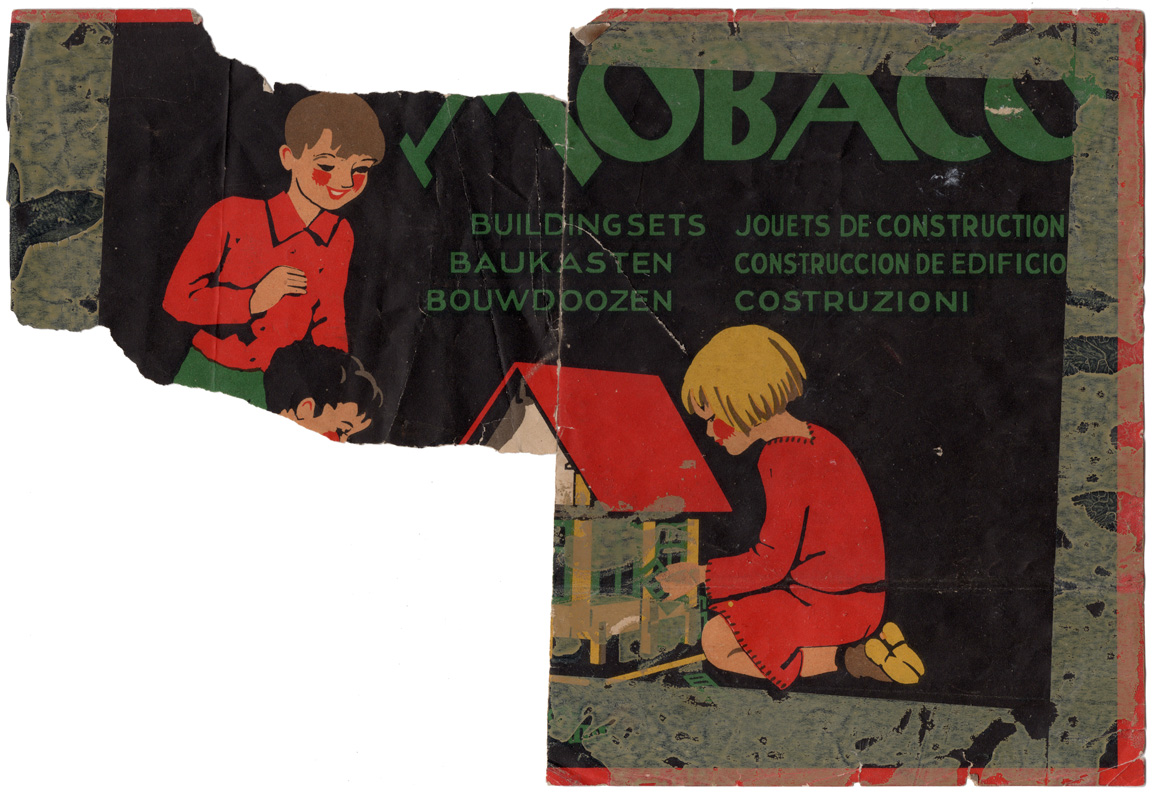  Original Courtesy of Nick Cranendonk November 1935 - Advertisement in De Huishoudschool This lovely ad mentions Sets 01, Garage 1 and Garage 2. It also mentions that Mobaco is available through your office stationary store ("kantoorboekhandelaar"). Blikman & Sartorius in Amsterdam were the sole distributor for office stationary stores. 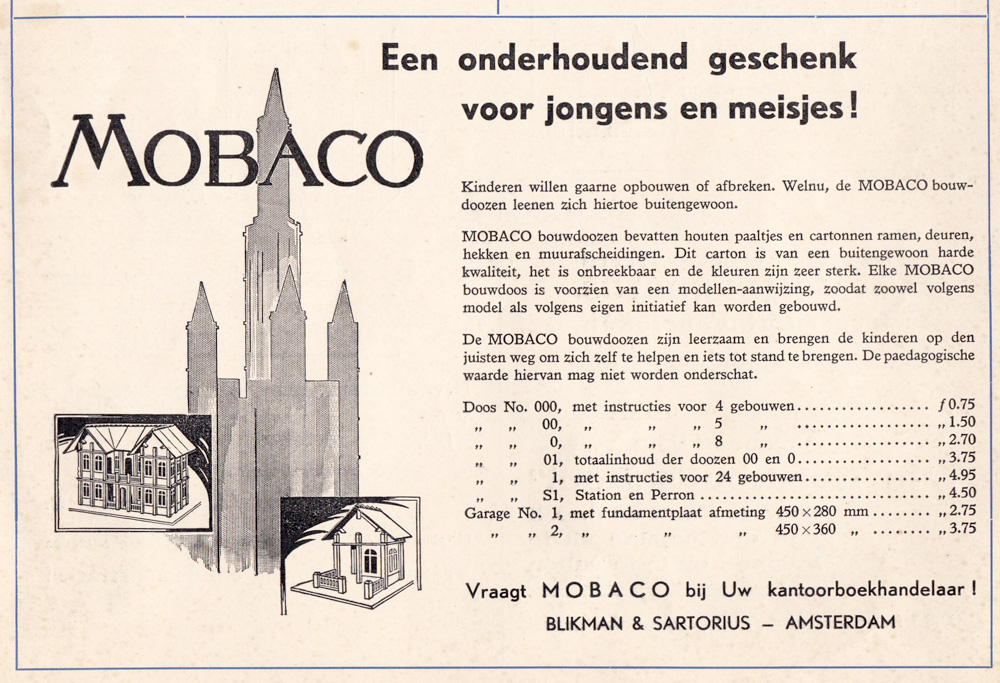 Scan courtesy Leen Kalden Undated #12 (September? 1936) The number of parts in Set 1 is reduced from 252 to 174 and the number of parts of Set 1a is increased from 203 to 282. DATING In this undated price list, prices are the same as in the August 1935 list above except that the price of Set 000 is now increased from fl 0.75 to fl. 0.90. So this list comes after August 1935. But all newspaper ads in 1935 show Set 000 for fl. 0.75, including the last known ad dated 17 December 1935, so this price list must come after 17 December 1935. A note on the price list states that Stations No. 1 & No. 2 and Garages No. 1 & No. 2 are no longer produced and are available until stock runs out. Since the Garage sets were introduced in 1935, this Undated #12 must be from after the holiday season of 1935. This makes the earliest possible date January 1936. All prices in this price list are identical to the October 1936 list below, except that a new Set 0a was added to that price list. So this price list must be from before October 1936. All in all, this price list must be from between January and September 1936. But wait, there's more: In het Utrechts Archief (municipal archive of the City of Utrecht), we found a 1936 accounting book from printing company Steendrukkerij Nout & Co which indicates that Moubal made three payments to them in 1936, specifically: - 24 November 1936: fl. 596.45 - 8 December 1936: fl. 68.26 - 22 December 1936: fl. 59.50 We believe Steendrukkerij Nout & Co was the printer for all color print work for Mobaco (brochures, manuals, price lists, box labels, stationary) from 1924 through 1942. Moubal made no other payments to Nout & Co in 1936, only in November / December. There is probably a two-month lag between invoicing and payment, so the print work itself is likely from September / October 1936. The next brochure below is dated October 1936, so it's covered by those payments. But how about this undated brochure #12, when was it printed and paid for? My original assumption was that Undated #12 dates from the spring or summer of 1936, but how do you explain no payments to Nout & Co earlier in 1936? Options: - the bookkeeper at Nout & Co didn't correctly tag an earlier payment received from Moubal (unlikely) - Moubal was in arrears and paid an older invoice for Undated #12 in December - This Undated #12 brochure was also printed in September / October. In the first print run they forgot to put in the new Set 0a and so they made a second print run, also in September / October, with Set 0a added, as well as a date at the bottom of the page (Oct 1936). That second print run is the next price list below. I find the last explanation the most likely. Which would mean that this price list Undated #12 is from September/October 1936 and pre-dates the price list below by just a few days or a few weeks. Assuming a two-month delay between invoice and payment, it's possible this Undated #12 was printed on ±24 September 1936 and paid for on 24 November (as part of a large print order which also included manuals, labels for boxes and possibly colorful Mobaco stationary), and that the October 1936 price list below was printed on ±8 October 1936 and paid for on 8 December 1936. It is also possible that Undated #12 was paid for on 8 December and the next version paid for on 22 December. Since the cost of both orders is roughly the same, that would mean that Moubal ended up with twice the number of price lists as originally intended. That would seem rather wasteful. My thought is that the second version, with Set 0a added to the list, was primarily printed for retailers so they could order sets from that list, while the availability of Set 0a was not really important for the price lists that were stuffed into boxes. This means the second print run could have been fairly modest, and they didn't have to throw away many price lists, which, considering the deep recession, was something they wouldn't do. Then there is the issue of timing. Working back from Sinterklaas, the Dutch Santa Claus, celebrated on December 6th, Mobaco would have to be on the shelves in toy stores no later than mid-November. To achieve distribution in time, production of the sets must have been completed by the end of October, giving them two weeks to get all the Sinterklaas sets to stores, possibly via a distributor. Say they could do the entire production cycle in a month, making parts, making boxes and stuffing the boxes, which is quite an aggressive schedule, then the print work would have had to be ready by the end of September. This would indicate that, indeed, Undated #12 would have been part of the large print order run on ±24 September 1936 and paid on 24 November 1936. And the next version (Oct. 1936) would have been printed on ±8 October and paid for on 8 December 1936. This is all conjecture! But not unlikely. The note that "Stations No. 1 & No. 2 and Garages No. 1 & No. 2 are no longer produced and are available until stock runs out" also tells us that Garage sets were only produced in 1935. Despite high hopes that these lovely sets might entice buyers despite the bad economy, sales must have been disappointing. Moubal must have been left with quite a bit of stock after the 1935 Sinterklaas and Christmas season, and decided to stop production and sell what they had. It's quite possible that they did not make a lot of money on these sets. The Garage sets included many special parts, had large base plates and thus large boxes, and were priced attractively, so margins may have been thin to start with.   Scans courtesy Nick Cranendonk There is a second version of this price list (Undated #19) where the note about Train Stations and Garages being available until stock runs out is to the left, and on the right is a note that sales for bookstores in the Netherlands are through Blikman & Sartorius, Amsterdam (same note as in August 1934). If you look carefully, you see that there is an overprint. The number of parts for sets 1 and 1a is both the old count and the new count, as well as the prices for these two sets. The number of buildings that can be built with Set 1 is 24, with overprinted "diverse" (= several). The price for Set 000 is overprinted as being 0.90. And the note about the Train Stations and Garages appears to be an overprint as well. In other words, this second version pre-dates the version above. This is the earliest version of a price list with new part counts for Sets 1 and 1a. Date is unknown, but like the version above between January and September 1936, and probably closer to September 1936. 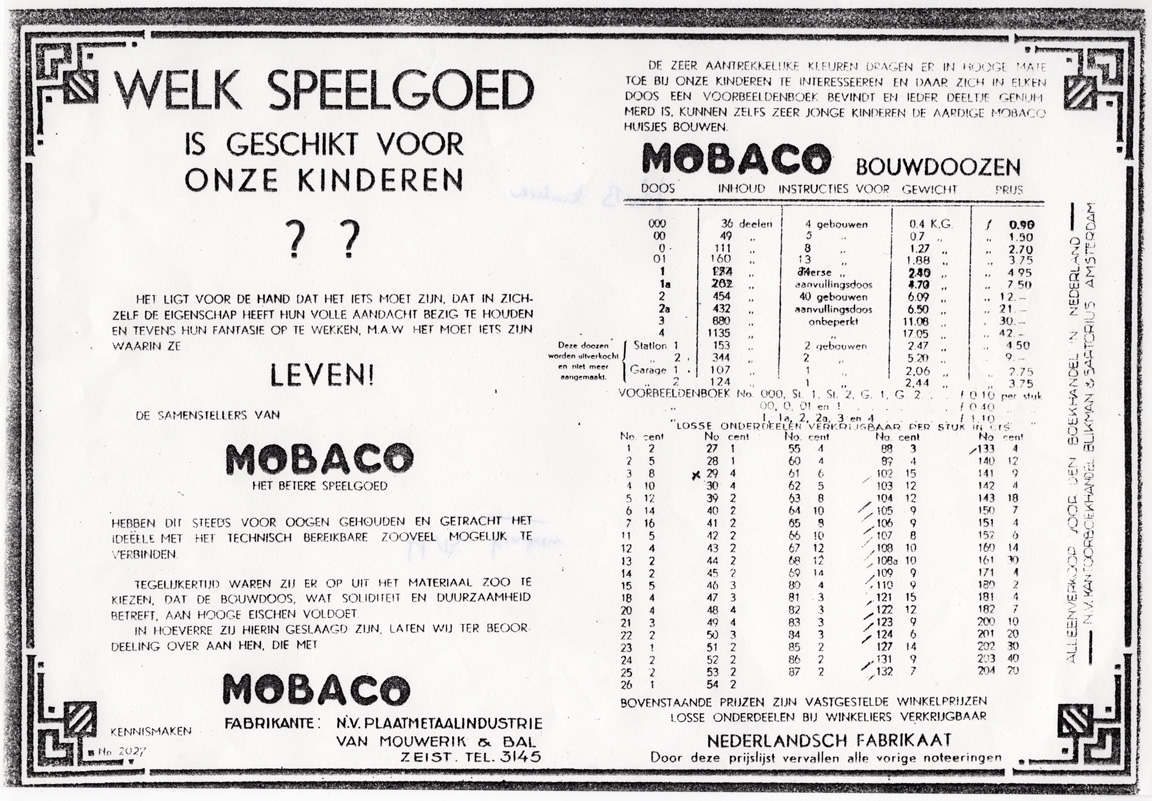 Original (photocopy) courtesy of Nick Cranendonk October 1936 The date is printed at the bottom of the price list. Set 0a appears for the first time. For the rest, the prices are the same as Undated #12 (September? 1936) above. A note on the price list states that Stations No. 1 & No. 2 and Garages No. 1 & No. 2 are no longer produced and are available until stock runs out. This is the last time these 4 sets appear on a price list, as well as their corresponding manuals.   Original courtesy Nick Cranendonk 2 December 1936 - Advertisement in Delftsche Courant This is the first known advertisement that mentions the Windmill sets ("Molen"). The Windmill sets don't appear on any Moubal price lists, making dating especially difficult. They are rare, so they must not have been available for a long time. Based on this ad and the next two, we know they were available in 1936 and 1937.  Scan courtesy Leen Kalden May 1937 - Advertisement in De Vrouw en Haar Huis The photo shows the larger of the two sets, Windmill No. 2. However, it is put together incorrectly: the larger base plate is supposed to go above the door! In the instructions, Mobaco used the same incorrect photo, but the narrative clearly states that the larger plate is supposed to be up. Which is how it should be: real windmills have a wide balcony at the upper level, for the miller to reach the sails and to rotate the turret.  Scan courtesy of Leen Kalden 26 November 1937 - Advertisement in Leeuwarder Nieuwsblad This advertisement mentions the Windmill sets ("Molenbouwdoozen"). Strangely, they still use the "old" spelling with two o's, three years after the new spelling officially went into effect. This is the last known advertisement that mentions the Windmill sets. 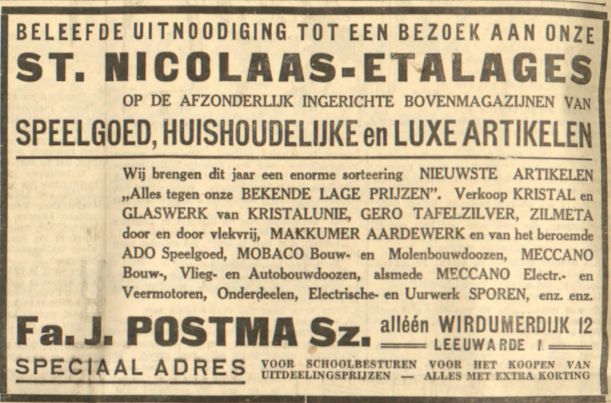 Scan courtesy Leen Kalden July 1937 The Train Station and Garage sets no longer appear on the price list, and we're back to the 11 sets that were available in 1932. Sets prices have gone up substantially, about 30%! This was due to the devaluation of the guilder and the resulting material price increases, as explained in a letter from Moubal to its retailers (see below). In September 1936 the government dropped the gold standard which led to the devaluation of the guilder. The Netherlands was one of the last countries in Europe to do that. Manual 00+0+1 with the colorful gnomes is split into two manuals with red+black covers, one for set 00 and one for sets 0 and 1. Clearly a cost-savings measure. Together they cost as much as the old 00+0+1 booklet. This would indicate the switch happened in (early) 1937. Based on other data it could also have been in 1936. Parts prices increase for the first time since there were parts prices on price lists (1932). Average increase is almost 40%! 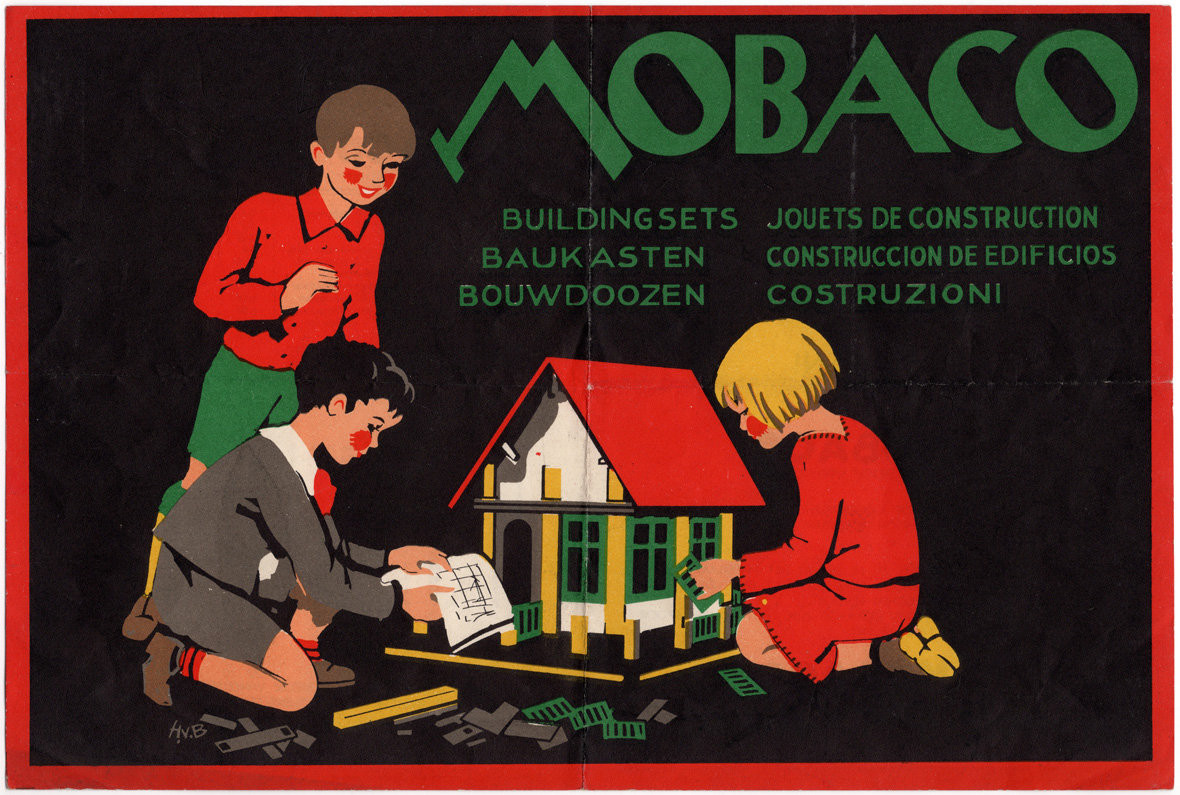 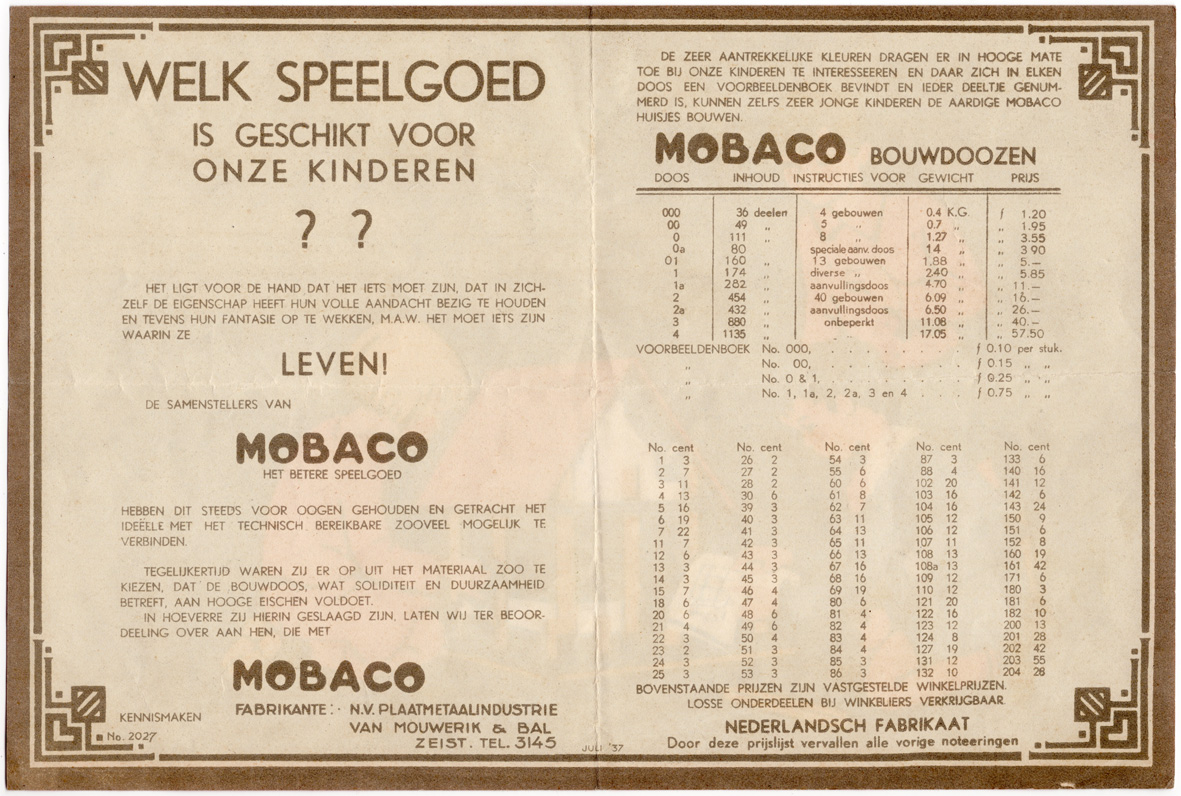 Original courtesy of Nick Cranendonk Letter from Moubal to retailers about price increases in July 1937. The text translates as: Zeist, date of postmark.This letter was sent to Hausemann & Hötte, a wholesaler who sold many toys, including Mobaco. Handwritten at top left is +600 7/8 '37 which infers that this letter was received on or before 7 August 1937. Note that the letterhead, which was printed in November 1934 (10,000 copies), features a building made with Set Z parts (which were never commercialized) and the Moba Puzzle (commercialized in December 1933):  Scan courtesy of HONGS.nl August 1937 This is the last known price list with the illustration of playing children by artist Eelco ten Harmsen van der Beek. Found so far is only a photocopy of the back, but it shows enough bleed-through of the front image to be able to identify it as the one with the playing children. Except for the date, this price list is identical to the July 1937 version. It has a stamp of Frans van Pelt, Papestraat 13, Den Haag, which was a store in luxury goods and toys. 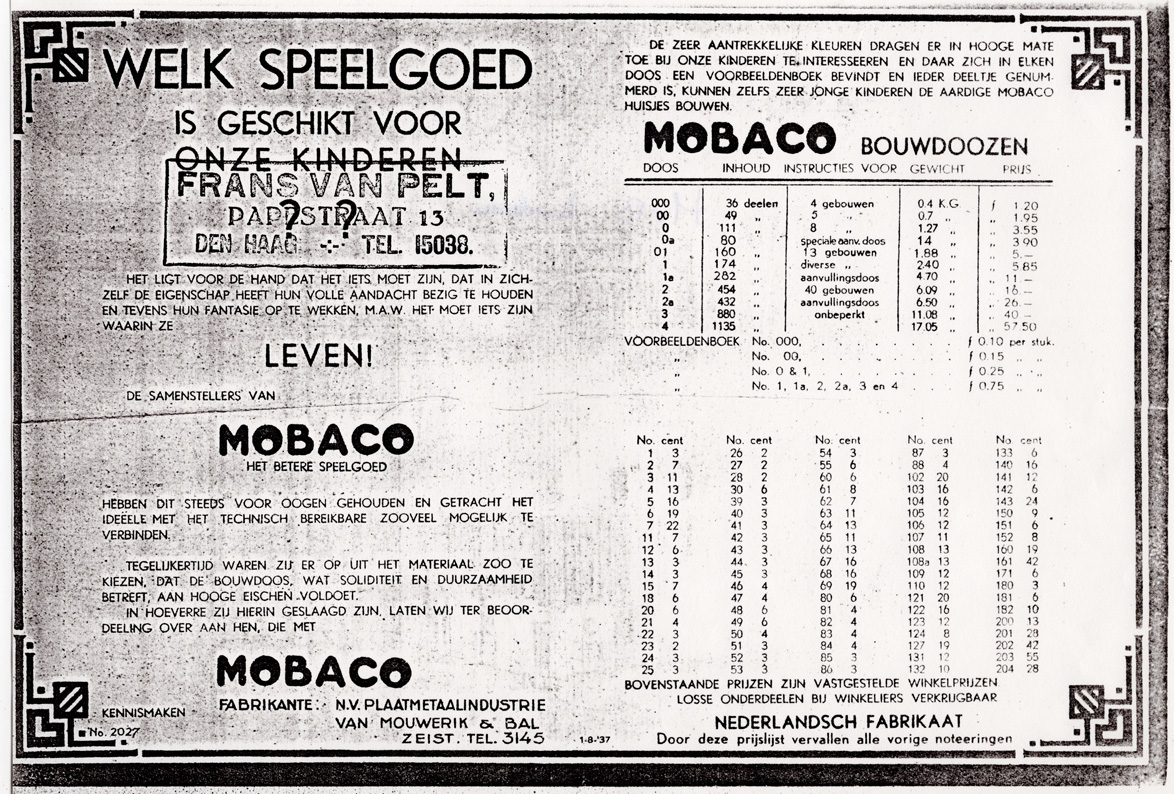 Original courtesy of Nick Cranendonk September 1937 After 5 years with the illustration of playing children, starting in September 1937 a new illustration graces the cover of the price lists, with more emphasis on small houses. Perhaps a sign of the times, or perhaps a desire to reach a broader public? Either way, it presages the post-war relaunch by Jumbo, which focused on much smaller sets. The illustration shows a windmill, which suggests that the Windmill sets might be available, although none are listed on the back. It also shows a drawbridge, which may suggest that they had plans to issue such a set. This is purely speculative, but not unthinkable, as the instructions in the Windmill sets state they were planning to come out with further specialized sets of typical Dutch buildings. Prices are the same as in July and August 1937.   Original courtesy of Nick Cranendonk September 1938 New is the addition of the Small Garage ("Kleine Garage"), which had a few special parts including a cloth roll-up door. With just 40 parts, this garage was much smaller than the discontinued Garage No. 1, which had 107 parts. The 1937 price increase may have been a bit too much. Prices for most sets were dropped 10% to 20%. Parts prices didn't change. This price list has a stamp from Firma J. Postma Sz, Wirdumerdijk 12, Leeuwarden, which was a luxury goods store with a toy section. 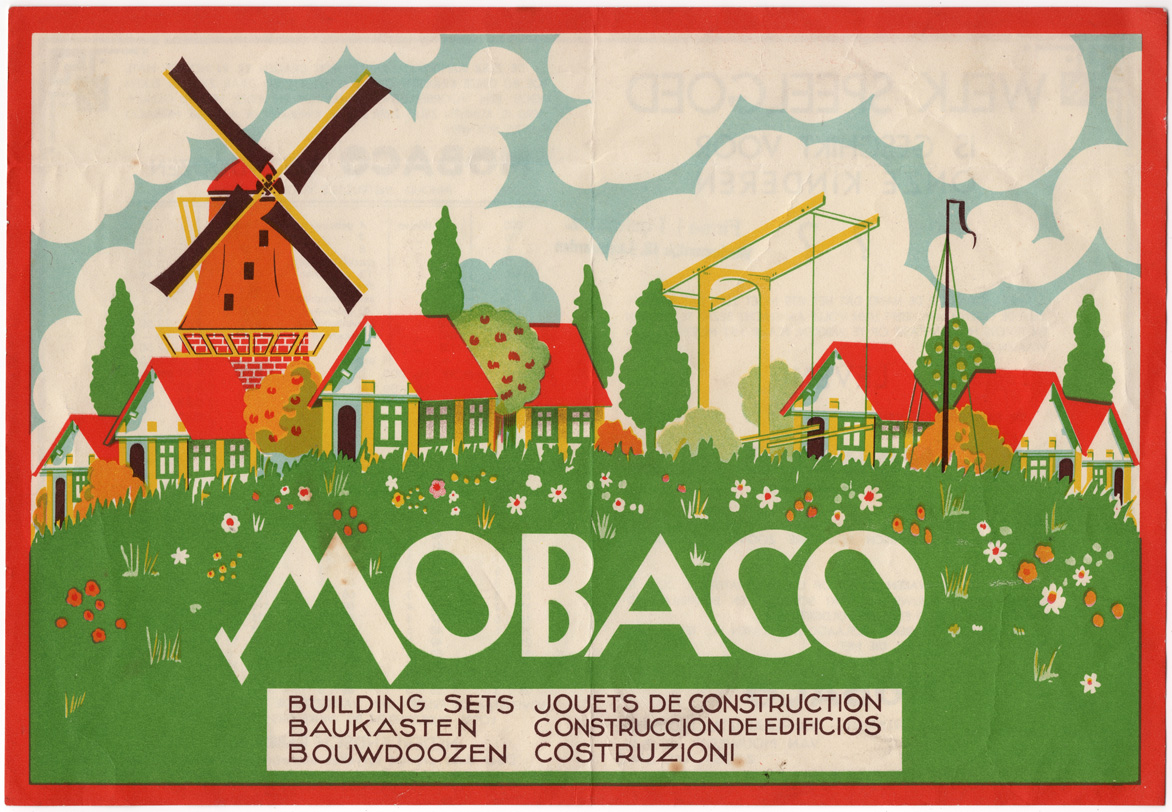 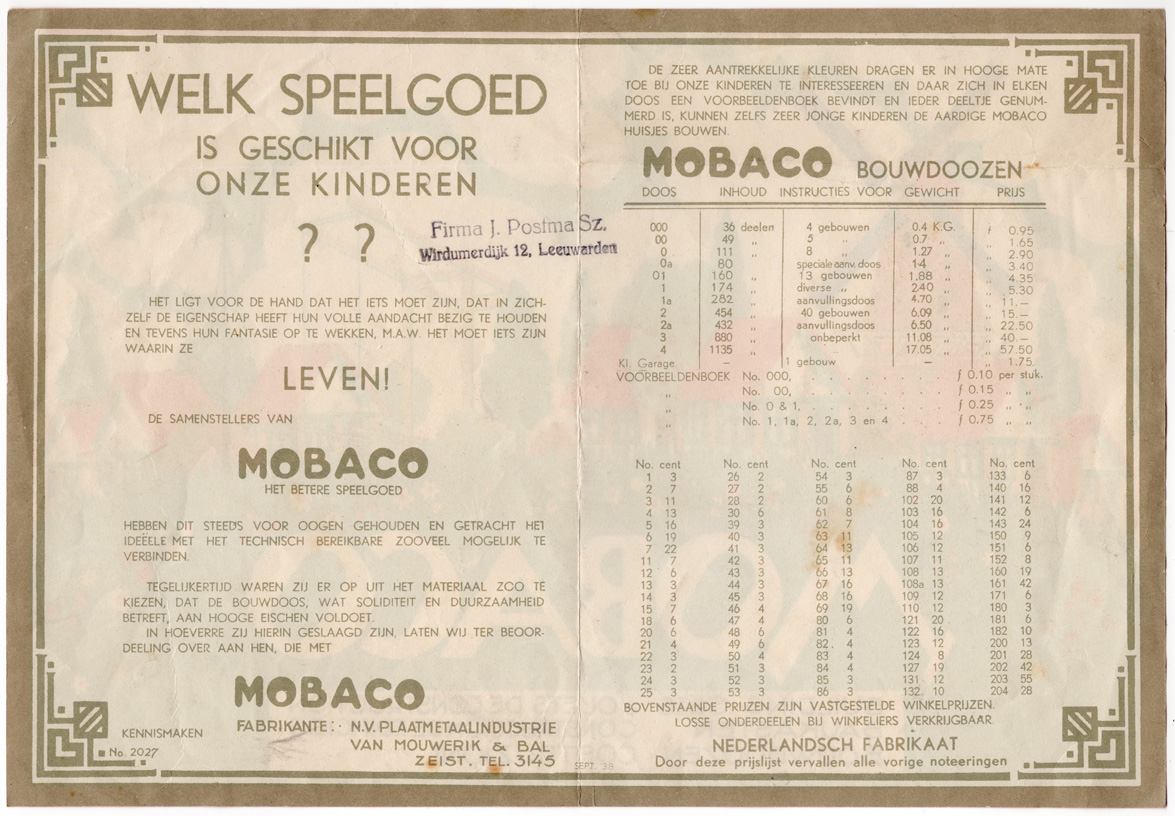 Original courtesy of Nick Cranendonk October 1938 Other than the date, this price list is identical to the September 1938 price list above: 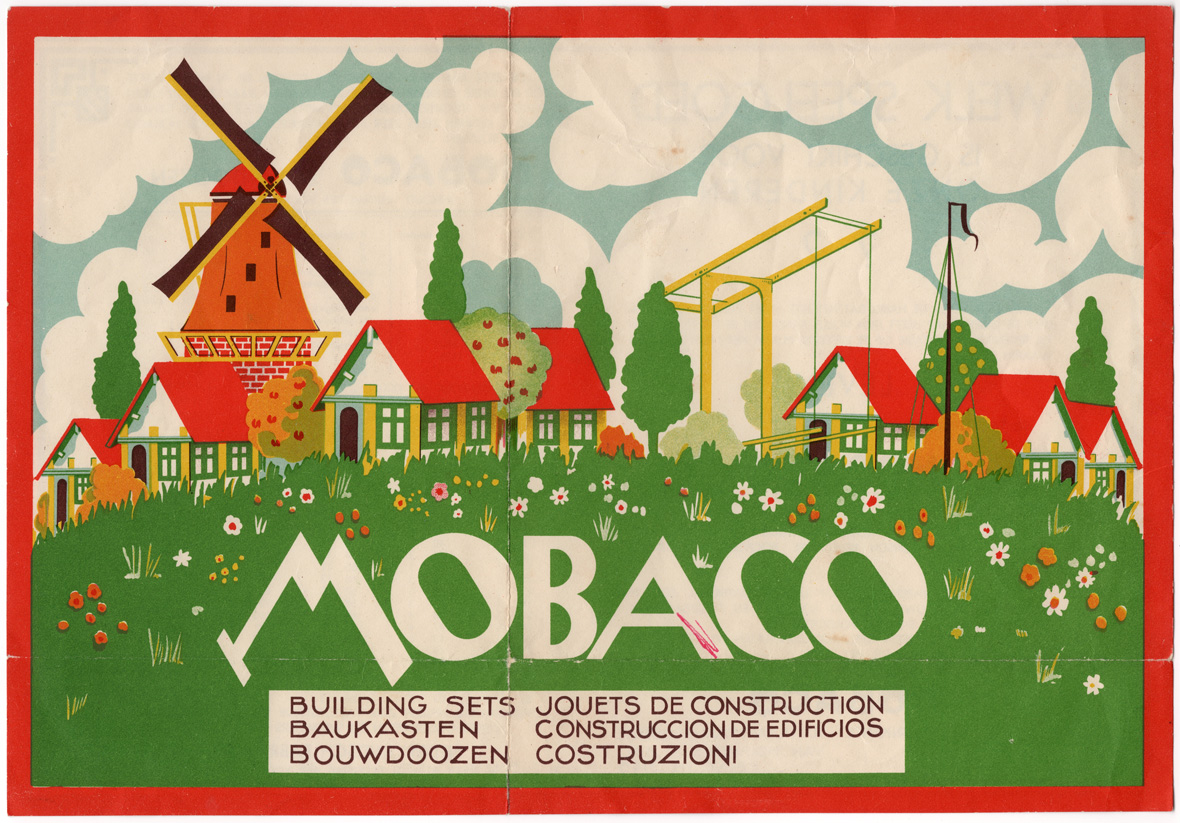  Original courtesy of Nick Cranendonk September 1939 This price list is pretty much identical to October 1938. Text, sets and prices are the same.   Scan courtesy of Henri de Graaf November 1939 This price list is identical to September 1939 and October 1938. Text, sets and prices are the same.   Original courtesy of Ida Gerrits May 1940 This is a rare May price list. Most of them are issued around October (Christmas season). Strangely, the date, 5 May 1940, is 5 days before Germany invaded Holland (10 May 1940). Holland surrendered on 15 May 1940, after heavy bombardment by the German Luftwaffe completely destroyed the center of Rotterdam. Prices of sets went up by approximately 20%, but parts prices remained unchanged. I speculate that the list may have been printed after the surrender, but pre-dated for political reasons. 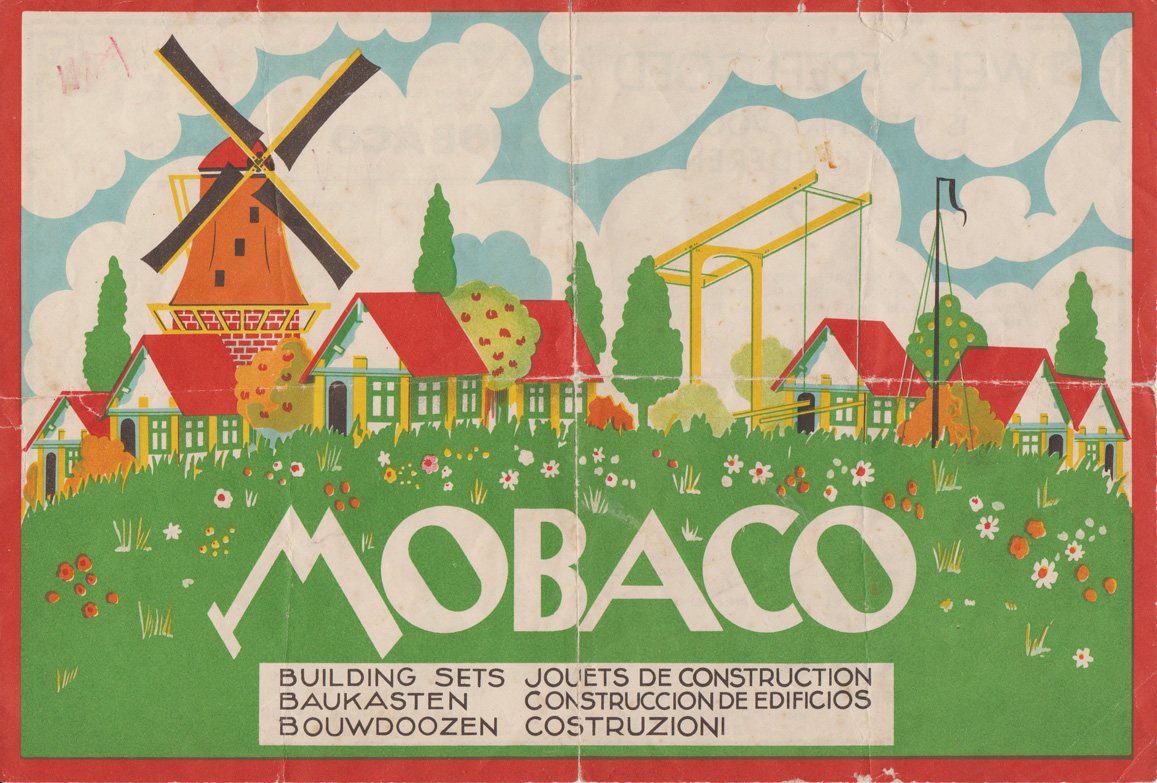 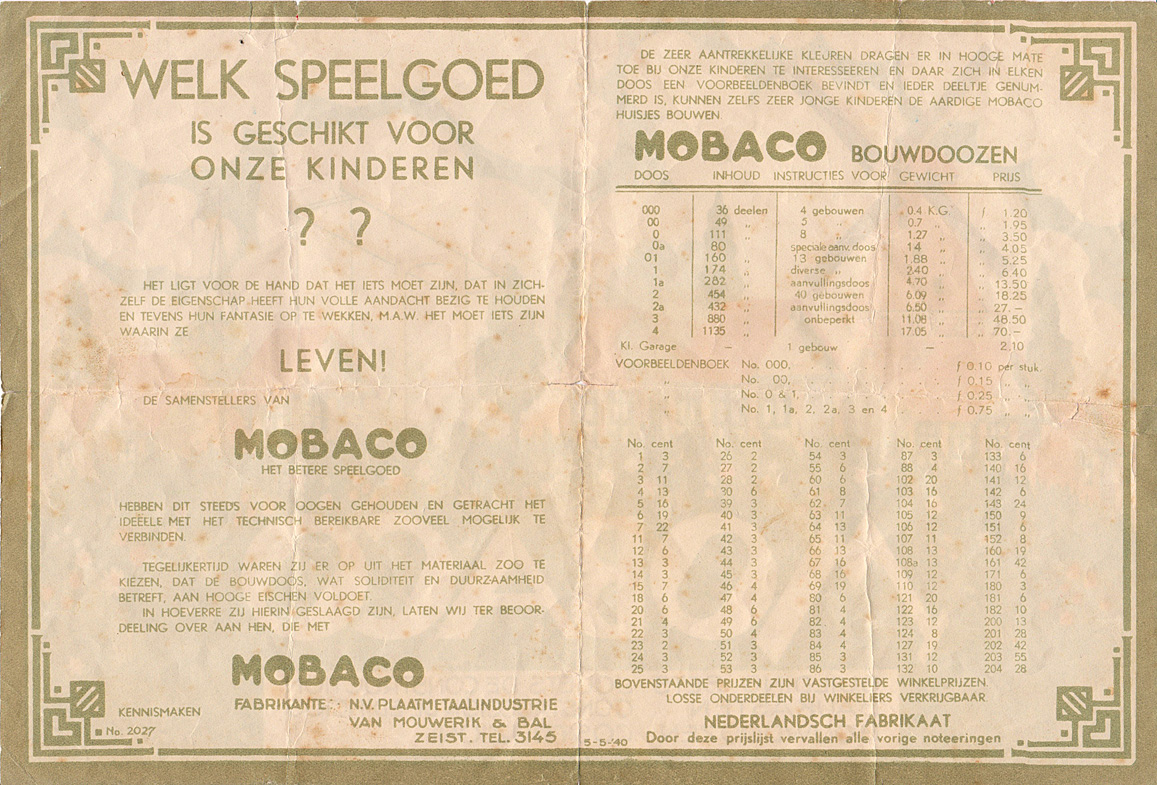 Scan courtesy of Leen Kalden October 1940 Prices are unchanged since May 1940.  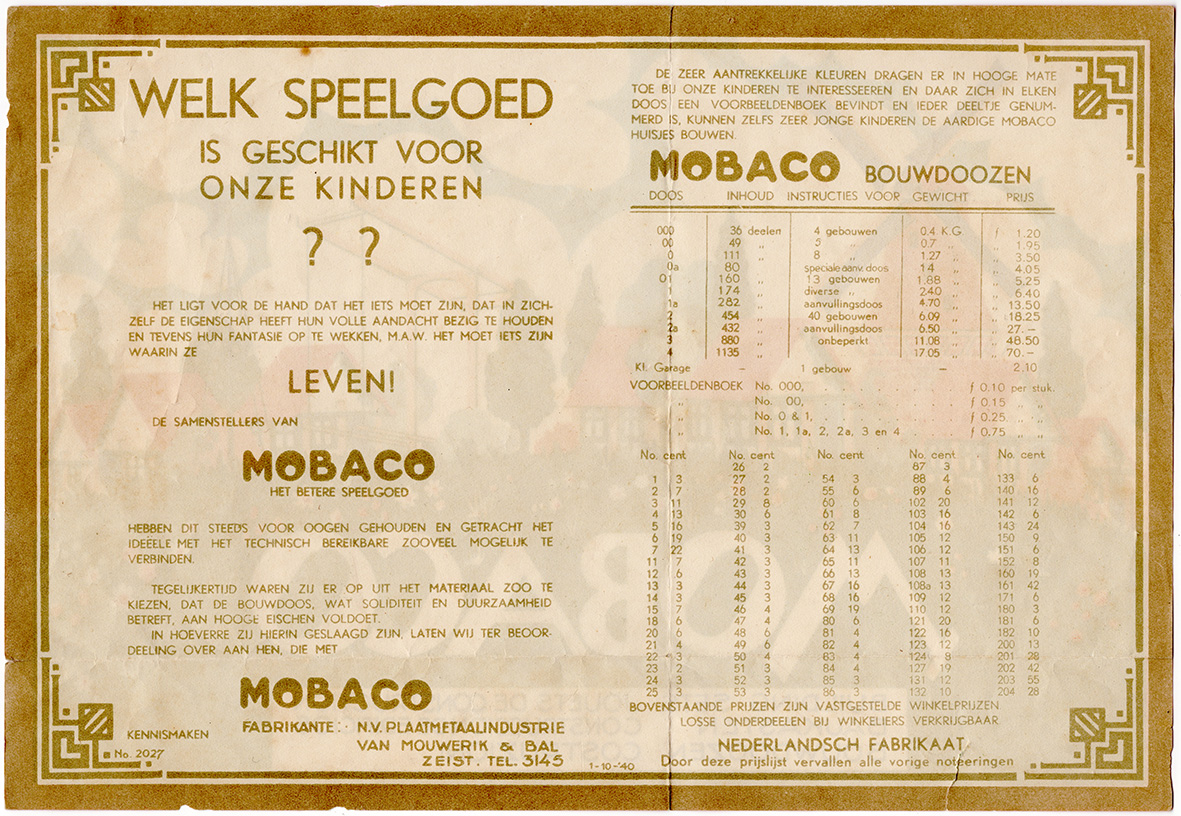 Original courtesy Nick Cranendonk May 1941 Prices are identical to the May 1940 price list.   Original courtesy of Barend Westerveld July 1941 Prices are identical to the May 1940 price list. 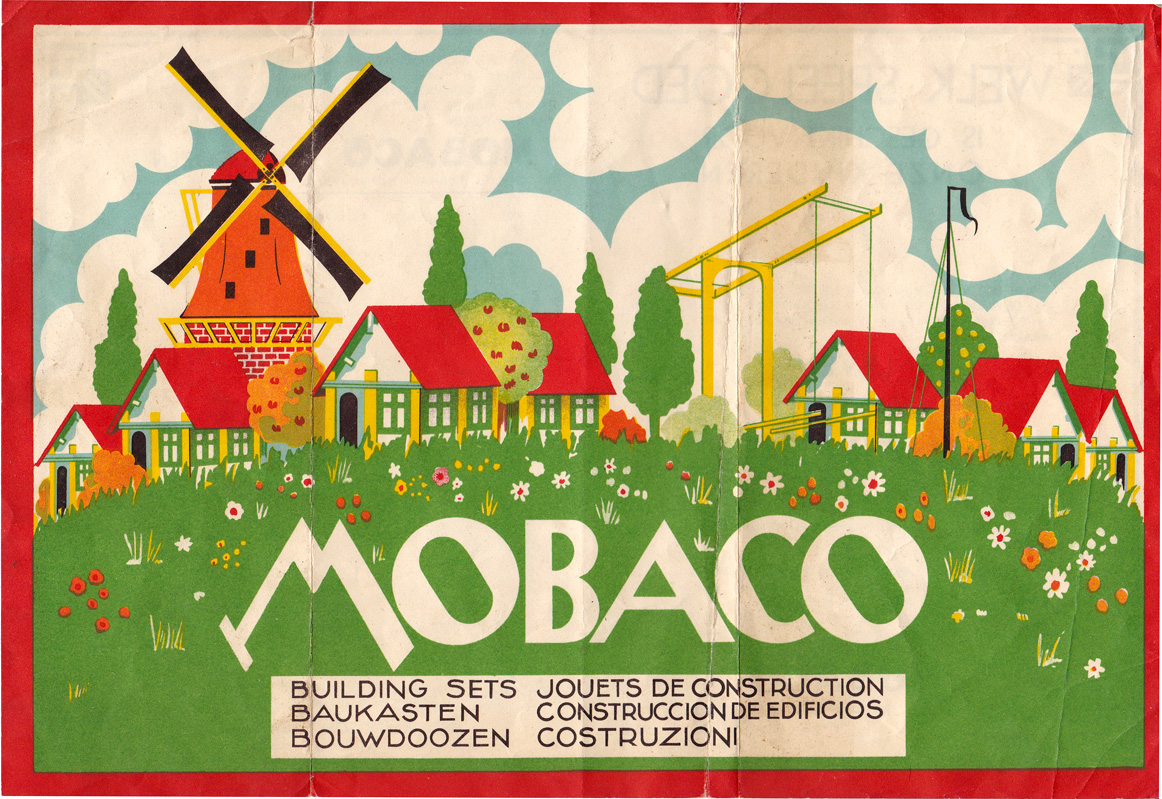  Scans courtesy of Leen Kalden Undated #5 - 1942? No narrative. No image on the reverse (the reverse is blank). The K-number refers to printer Drukkerij Verweij in Mijdrecht (south of Amsterdam, about 25 km from Zeist). DATING Sets prices are the same as in 1940 and 1941. Parts and manuals prices are the same as in 1937 through 1941. Not listed here is the Small Garage, which indicates that this list was made after July 5th, 1941 (that price list still shows the Small Garage). Bottom left features K1795, which was a printer code imposed by the occupier starting mid July 1941. This indicates that the price list must be from 1941 or later. Since there were already price lists printed in early July 1941 (see above), this price list is likely from 1942 or later. Severe shortages of everything make it highly unlikely that this price list is from 1943, 1944 or 1945, so it's likely from 1942.  Original courtesy Nick Cranendonk 27 February 1948 - Nieuwsblad voor Gorinchem This ad states: Received again for the first time are the original MOBACO SETS. This and a few other 1948 ads indicate that Mobaco was becoming more widely available again in 1948. I surmise that Moubal targeted the 1947 Christmas season, but due to materials shortages were unable to manufacture complete sets in time. By February they finally had what they needed and were able to deliver sets.  Scan courtesy Leen Kalden September 1949 This is the first known post-war price list. The war ended on 5 May 1945. This price list is from 4 years later. Sets prices are a whopping 120% higher than in 1941 and parts prices are 140% higher. This price list has been embellished with a box label left over from the war, with a K-number printed on it. It features the same 11 "standard" sets as before the war. Interestingly, the new tree parts 70 and 71 are listed, which then disappear from the Moubal price lists until March 1952.  Original courtesy of Nick Cranendonk 11 November 1949 - Advertisment in De Bel (Blaricum, Eemnes & Laren) These two post-war ads features both pre-war Moubal sets, and the new Jumbo A, B and C sets. The ABC sets are described as "something new from MOBACO". This indicates that Jumbo started selling the new sets in 1949. Presumably Moubal had left-over stock with pre-war sets that they wanted to get rid off, and they made arrangements with Hausemann & Hötte NV, makers of Jumbo games, to allow Moubal to continue selling the old sets for a few years until stocks expired. This is corroborated by the contents sheet glued to the inside lid of each ABC set, which states that even larger buildings can be made with Mobaco Sets 1, 2, 3 and 4. The ad on the right is from 11 November 1949 in the Stichtse Courant (Zeist). Prices of the Moubal sets are 127% higher than in 1941! 
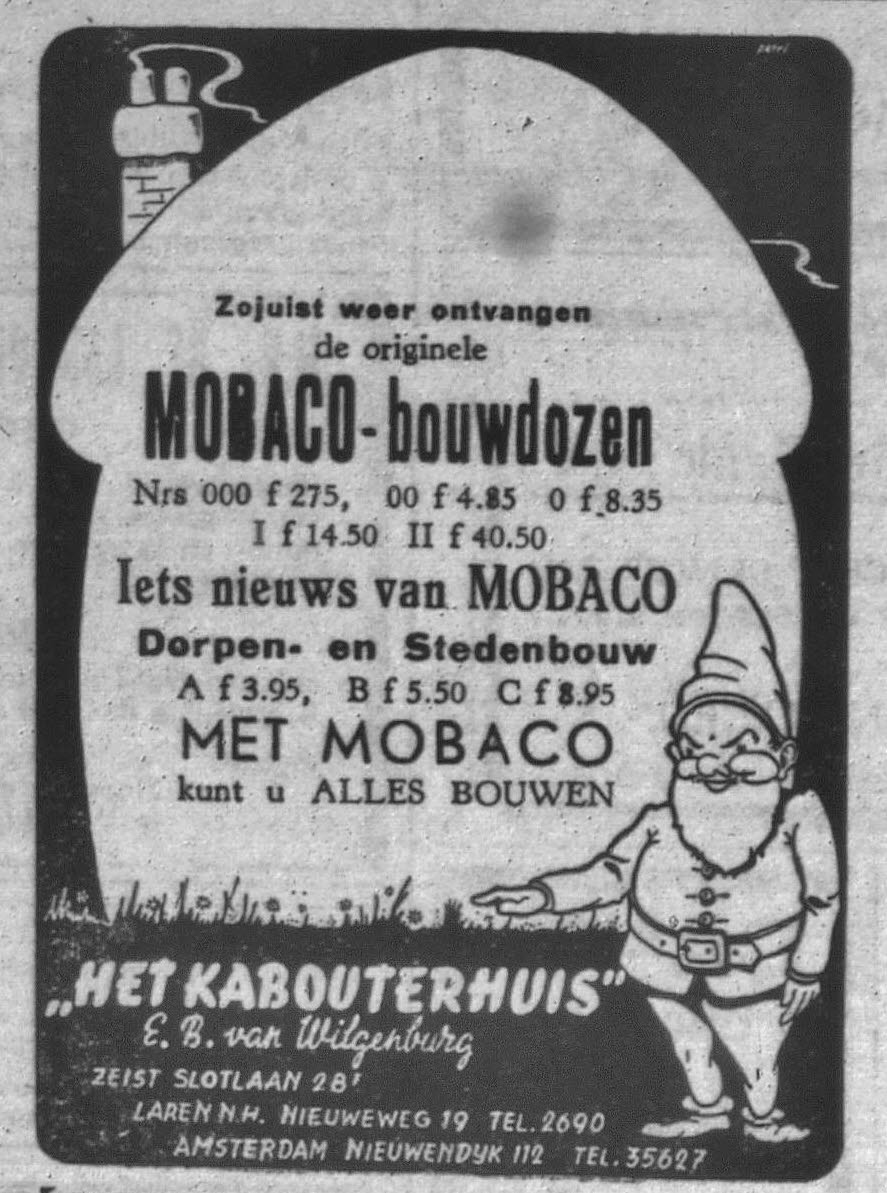 Scans courtesy Leen Kalden May 1950 Prices are a little lower than in September 1949. The image on the front is the same as the pre-war price lists, but the back has a more modern look with a simple border. This same border is used in the 1951 price list.   Scans courtesy of Robj Schiff September/October 1951 This price list features a new front design with the words: MOBACO, the little Architect. Educational toy. Available everywhere. Beautiful colors. Set prices are 35% higher than last year, and parts prices approximately 25% higher. There is also a version of this price list printed on light blue paper. 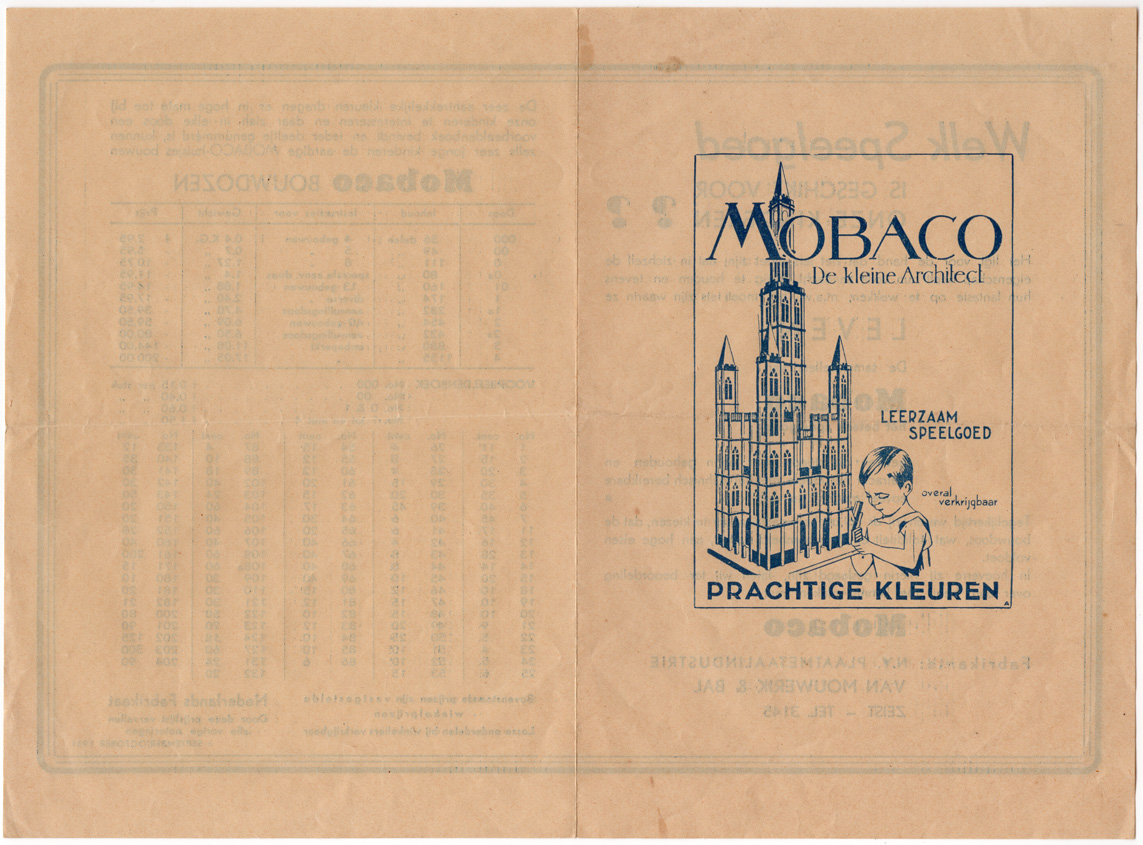  Original courtesy of Nick Cranendonk March 1952 This price list is generally similar to the price list above, except that there is additional text on the cover and parts prices now are on the back, arranged in the form of an ordering list, leaving more room for the sets prices. Also, it's now on pink paper. The typeface on the back has changed from a sans-serif font to a more tradition serif font. Set 000 has increased in price, the other sets stayed the same price. Sets 2a, 3 and 4 have been removed from the list. The parts list has a three new parts, #1-1/2, #70 and #71, all specifically made for Jumbo. Parts #71 and #72 first appeared on the September 1949 price list, but then disappeared from the Moubal price lists until this one. A few parts have a different price.   Scans courtesy of Henri de Graaf November 1952 This is the last known Moubal price list. It is very similar to the price list above. There are two new parts, #73 and #76, the small clock and the chimney, both parts that were specifically made for Jumbo. Prices are the same as in March 1952. Not long after this, Moubal stopped selling the pre-war sets, and Hausemann & Hötte NV, makers of Jumbo toys, were left as the sole sellers of Mobaco (post-war sets only). 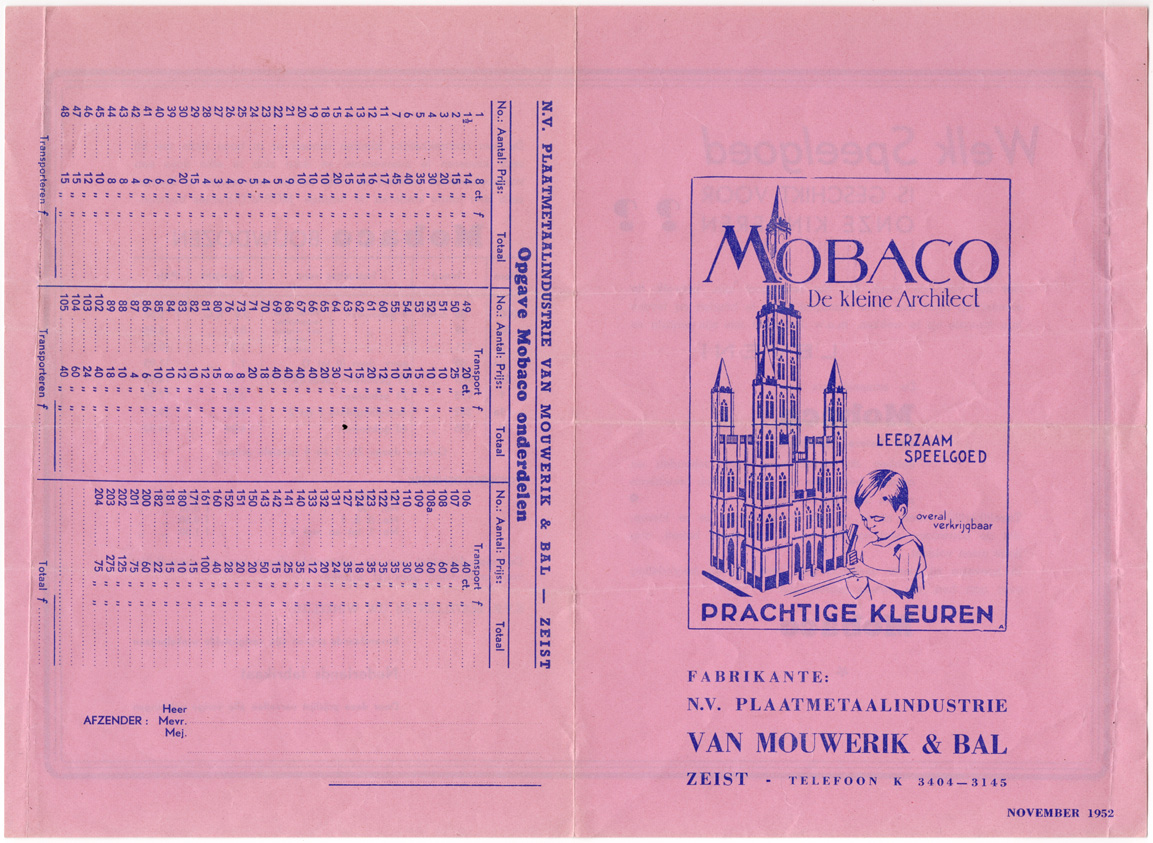 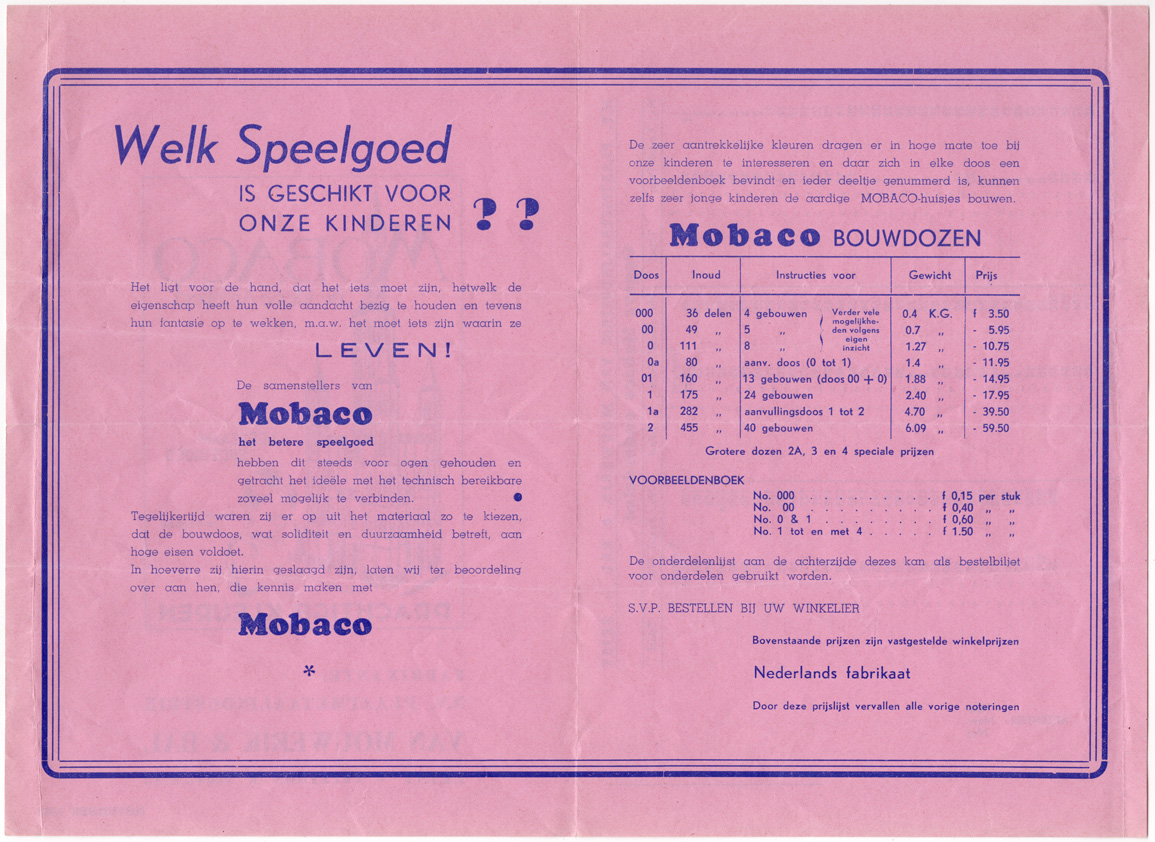 Original courtesy of Nick Cranendonk Miscellaneous Moubal Mobaco advertisements with prices Here a smattering of Mobaco ads with prices. They don't add new information about prices or chronology of sets, but are fun to peruse.
Starting in 1949, Hausemann & Hötte NV, makers of Jumbo games, takes over the marketing and sales of Mobaco. Initially, they come out with Set A in a simple red box, soon followed by a complete series A, B and C. In 1950, they change that to a series of four progressive sets named A, B, C and D, with upgrade sets AB, BC and CD. The contents of the new sets A, B and C are different from the initial series. Each set comes with a different booklet. Then, in 1951, they add Set E and make-up set DE, and make a single book A-E that is included with all sets. As the table below shows, there are regular price increases. The last known price list is from fall 1961. The 1960 price list mentions a Dealer's chest for the princely sum of 80 guilders! I have seen several price lists which are not shown here at the express request of the contributors, but the pricing info from those lists is included in the table below. Only 1954 is a bit of a mystery. In all likelihood, Undated #1 is from 1954. 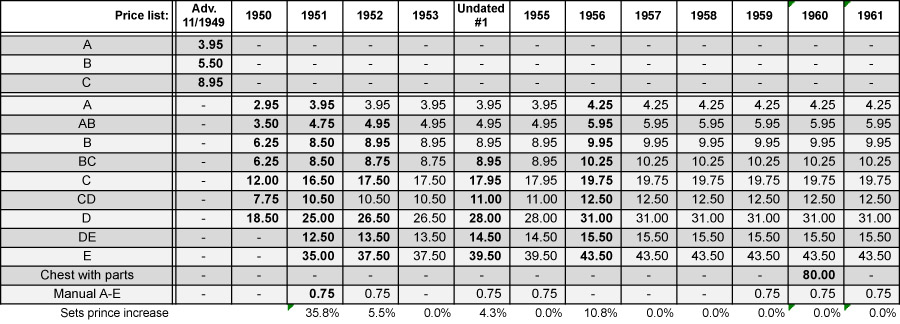 Jumbo also sold spare Mobaco parts, including parts that were not in any of the Jumbo sets! See bottom of page for an analysis of parts prices. 11 November 1949 - Advertisment in De Bel This is the first post-war ad that mentions the Jumbo A, B and C sets, which are advertised as being something new. This indicates that Jumbo started selling the new sets in 1949. The similar ad on the right is from 11 November 1949 in the Stichtse Courant (Zeist). 
 Scans courtesy Leen Kalden 1952 Het Speelgoedboek - Hausemann & Hotte NV This toy catalog is by Jumbo manufacturer Hausemann & Hotte in Amsterdam. It features the entire Jumbo Mobaco ABCDE range (5 sets + 4 make-up sets). 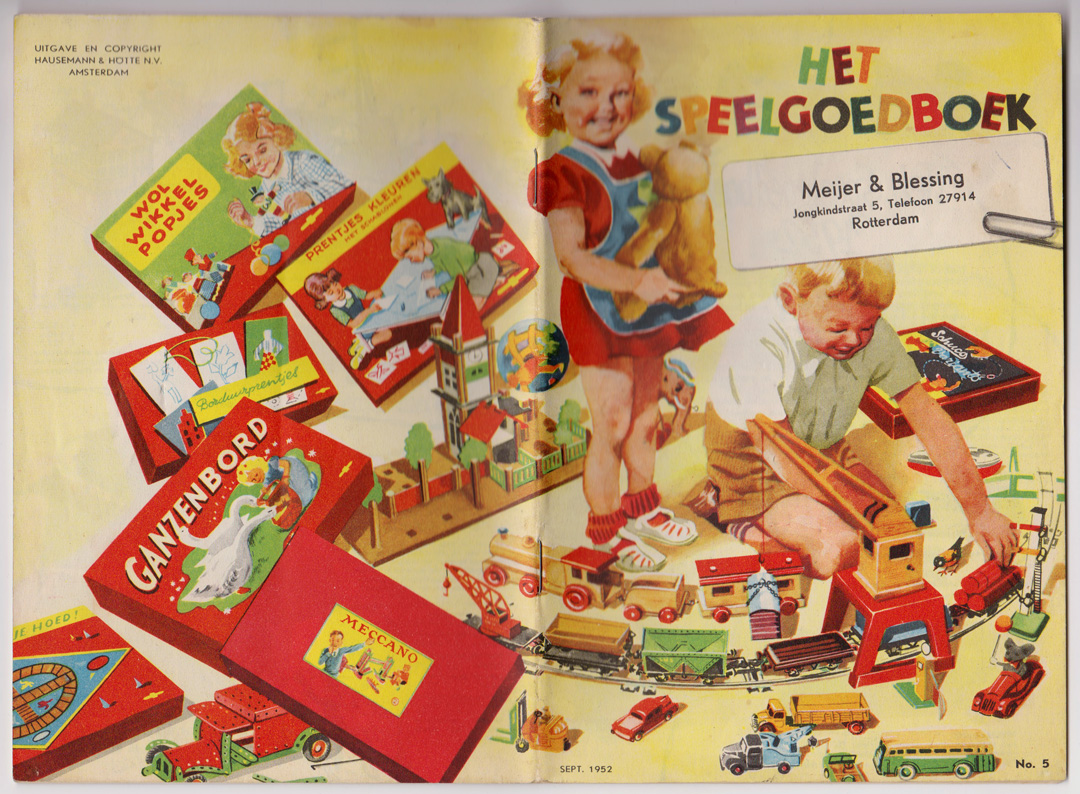  Scans courtesy of Leen Kalden August 1953 This efficient layout has parts illustrations, parts prices, set prices, an explanation of how the upgrade sets work, and space to order spare parts, all on one page. Overprinted prices show there was an earlier price list with lower prices. Those previous prices are for the most part identical to the prices listed in the last Moubal price list from 1951 (see above). The overprinted prices are tabulated in the overview table at the bottom of this page in column "Strikethru 8/53". Marking at the bottom right suggests a print run of 2500 copies, and is dated 10-'52. 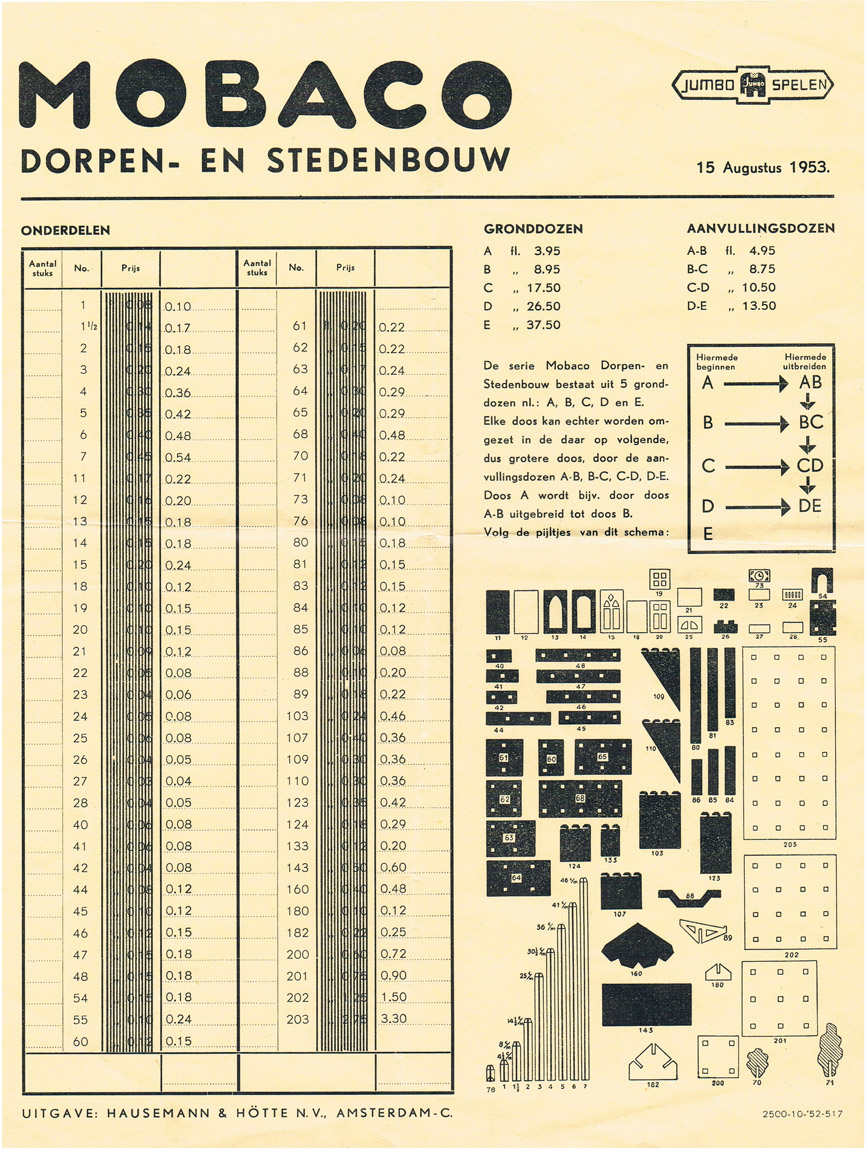 Scan courtesy of Robj Schiff Jumbo Undated #1 (1954?) Prices of sets C, D and E are higher than August 1953 above, but lower than 1956 below, so this must be from 1954 or 1955. Assuming that Undated #2 is from 1955, then this is probably from 1954.  131 x 97 mm (525 x 195 unfolded) 2 pages, folded into pocket-sized brochure with 16 faces Four-color printing See pages DOWNLOAD PDF  Scans courtesy of Leen Kalden Jumbo Undated #2 (1955?) This brochure is very similar to Undated #1. Differences are that the Jumbo elephant is colored blue, and the text in the footer is different and in color. Prices of sets C, D and E are higher than August 1953 above, but lower than 1956 below, so this must be from 1954 or 1955. Assuming that Undated #1 is from 1954, then this is probably from 1955. However, since there is an overprint with "Prices Void", these are probably left-over brochures that they used in 1956 when the prices were higher. But without the overprint it would have been 1955.  131 x 97 mm (525 x 195 unfolded) 2 pages, folded into pocket-sized brochure with 16 faces Four-color printing See pages DOWNLOAD PDF  Scans courtesy of Leen Kalden 1956 Advertisement Prices for all sets are higher than in Undated #1 above. 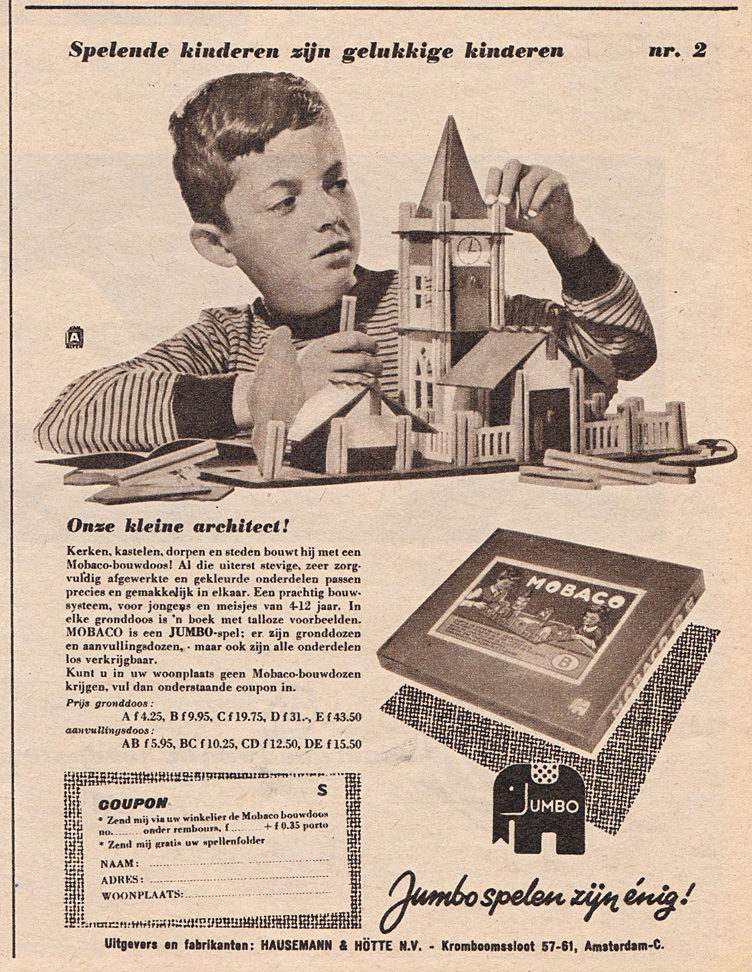 Scan courtesy of Leen Kalden 1957 Speelgoedgids This 1957 general toy catalog shows Mobaco Set B of the Jumbo ABCDE series. Pricing of Set A is the same as the 1956 ad above.  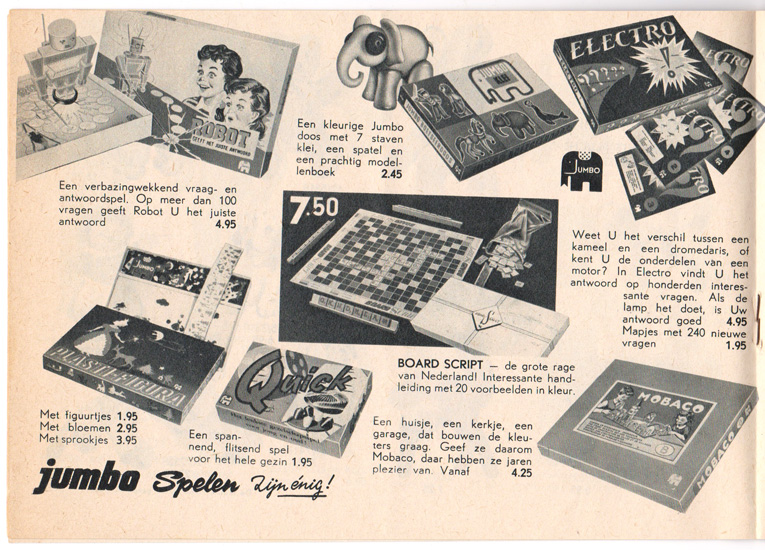 Scans courtesy of Leen Kalden 18 November 1958 advertisement in Agemeen Handelsblad This large Jumbo ad primarily features Mobaco. A note indicates that Mobaco is a product of van Mouwerik & Bal in Zeist. Prices of 4 sets are mentioned, same prices as in 1956 above and 1960 below. 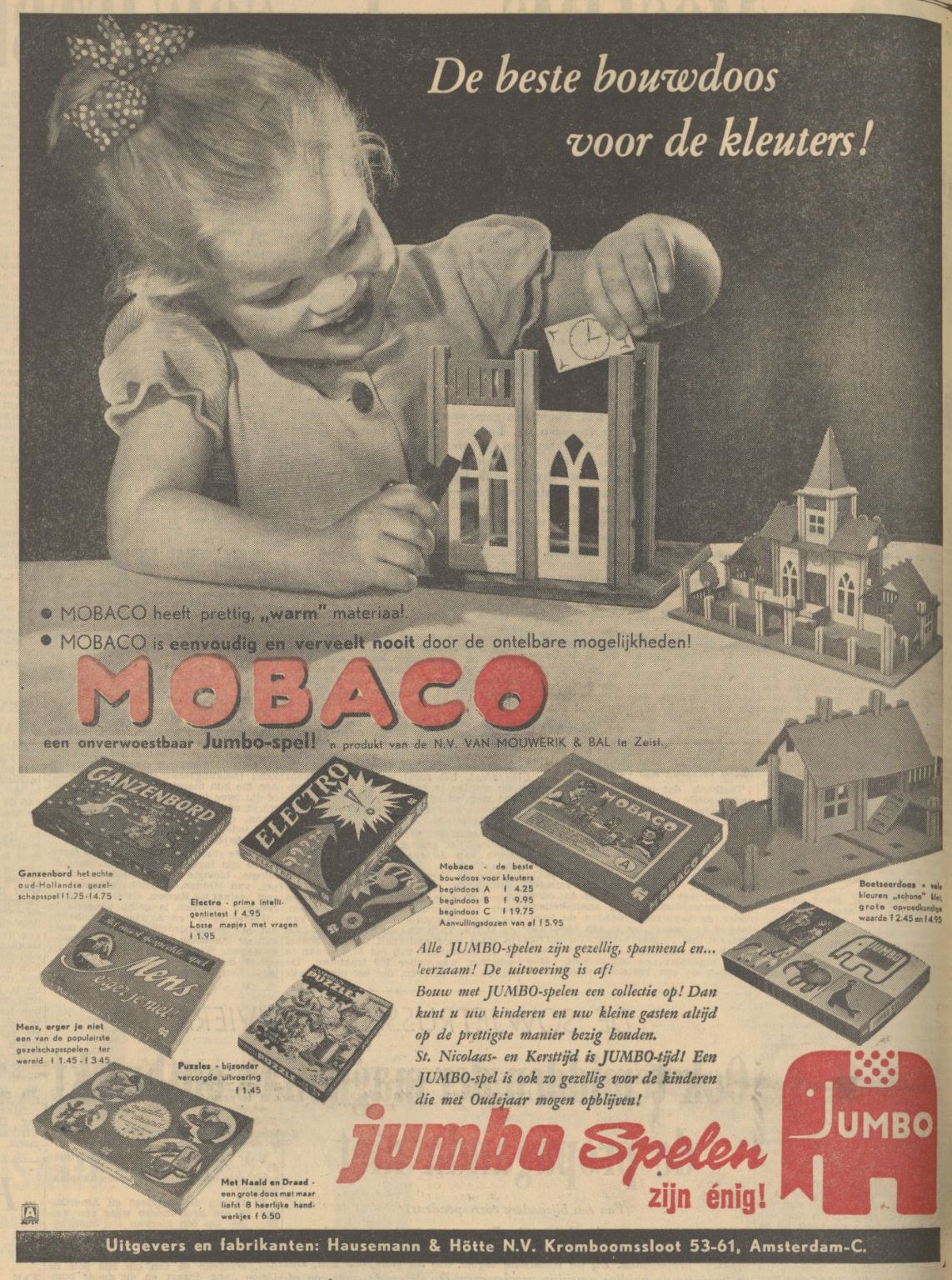 Scan courtesy of Leen Kalden 1959 Speelgoedgids This 1959 general toy catalog shows Mobaco Set A of the Jumbo ABCDE series. Pricing of Set A is the same as the 1956 ad above. 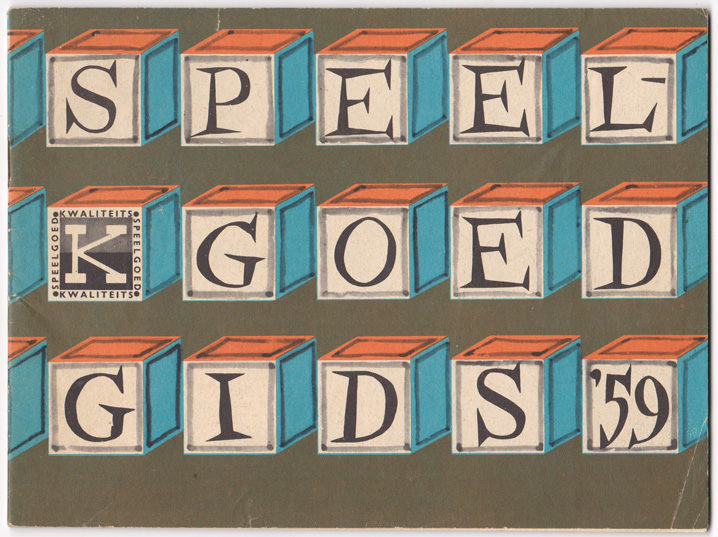  Scans courtesy of Leen Kalden September 1959 (?) Dating is based on the number in the bottom-right corner, 959, suggesting September 1959. Although this is by no means certain, it is not an unreasonable assumption. Prices are the same as in the 1956 advertisement above, and the same as the 1960 price list below. A marking near the Jumbo logo suggests that this is version No. 8 of the list.  Scan courtesy of Leen Kalden 1960 Jumbo 1960-1961 Price List, which includes Mobaco sets. Prices are the same as above. 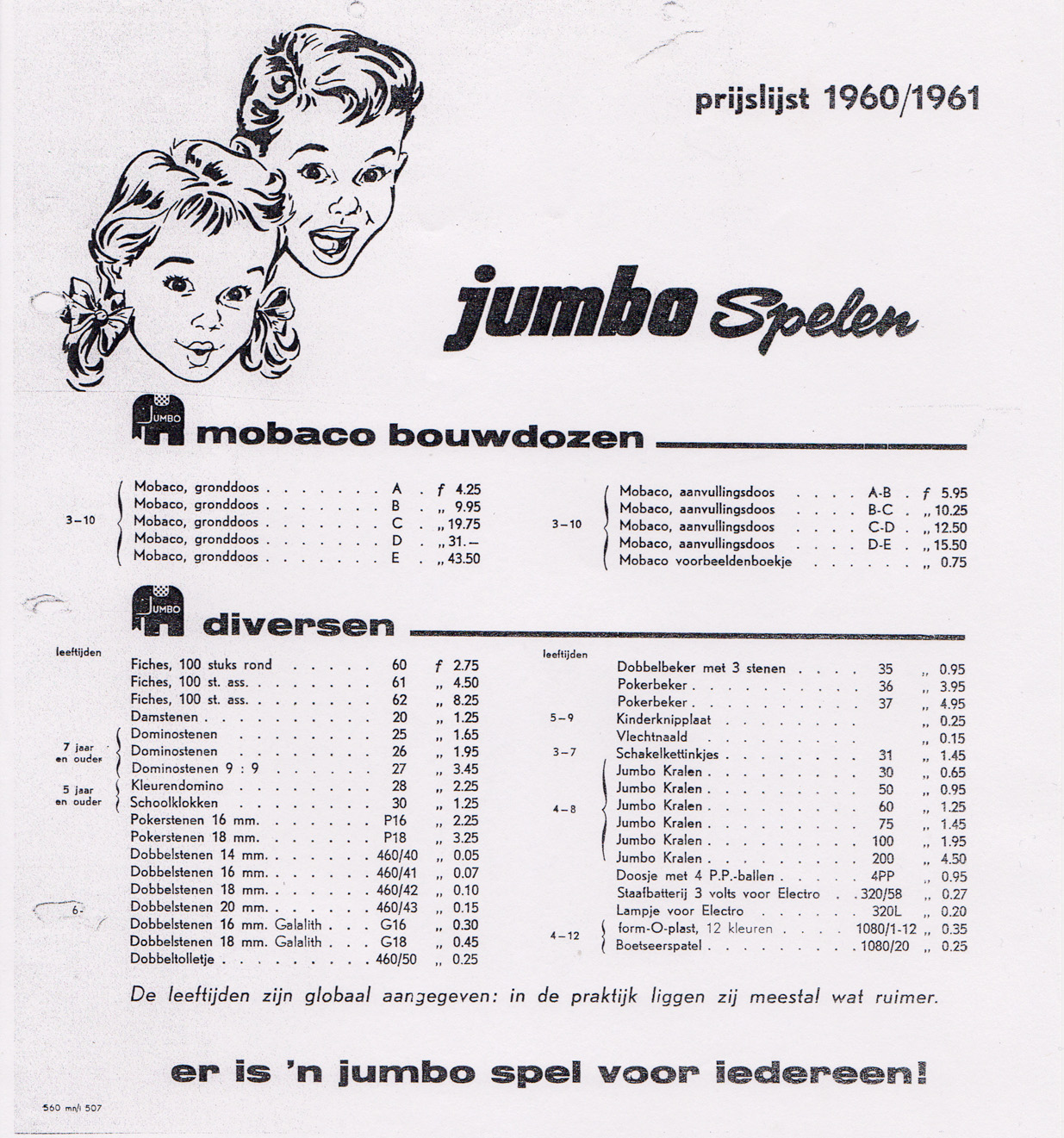 1960 This order list shows many of the Jumbo toy products, including Mobaco sets. Note how expensive most Mobaco sets are relative to the other toys. Although the list is undated, it mentions that starred items will be specially promoted in 1960. Also, the prices are the same as in the 1960-1961 Price List above. Interestingly, it also includes a dealer chest with parts, for a whopping fl. 80.–. It was a wooden box with dividers and many common parts. This is the only mention of the dealer chest found so far. 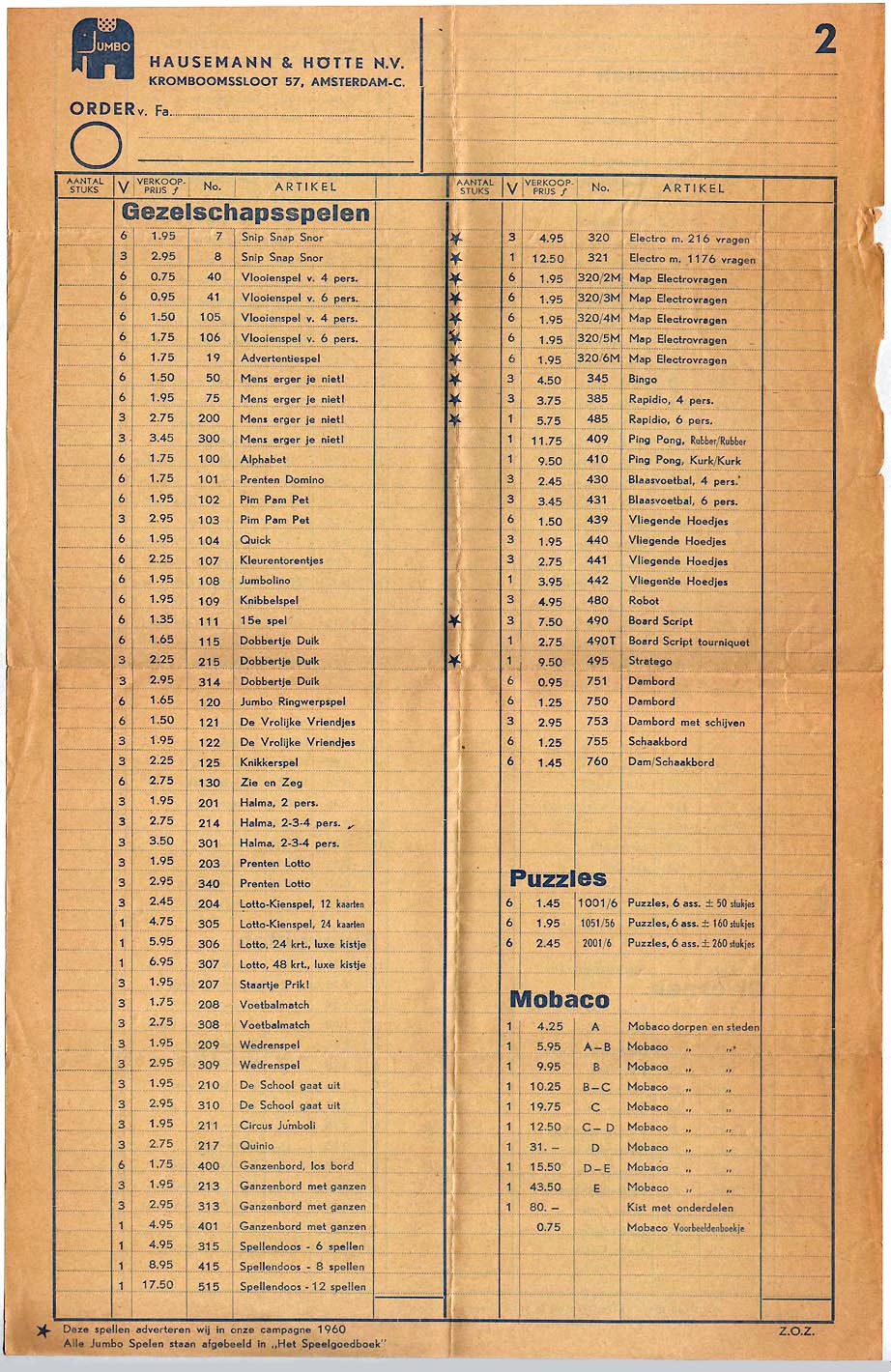 Scan courtesy of Leen Kalden 1961 Jumbo 1961-1962 Price List, which includes Mobaco. Mobaco prices are the same as in 1956 and the years after that. This is the last known price list for Mobaco. As far as we know, Mobaco was discontinued in 1962. 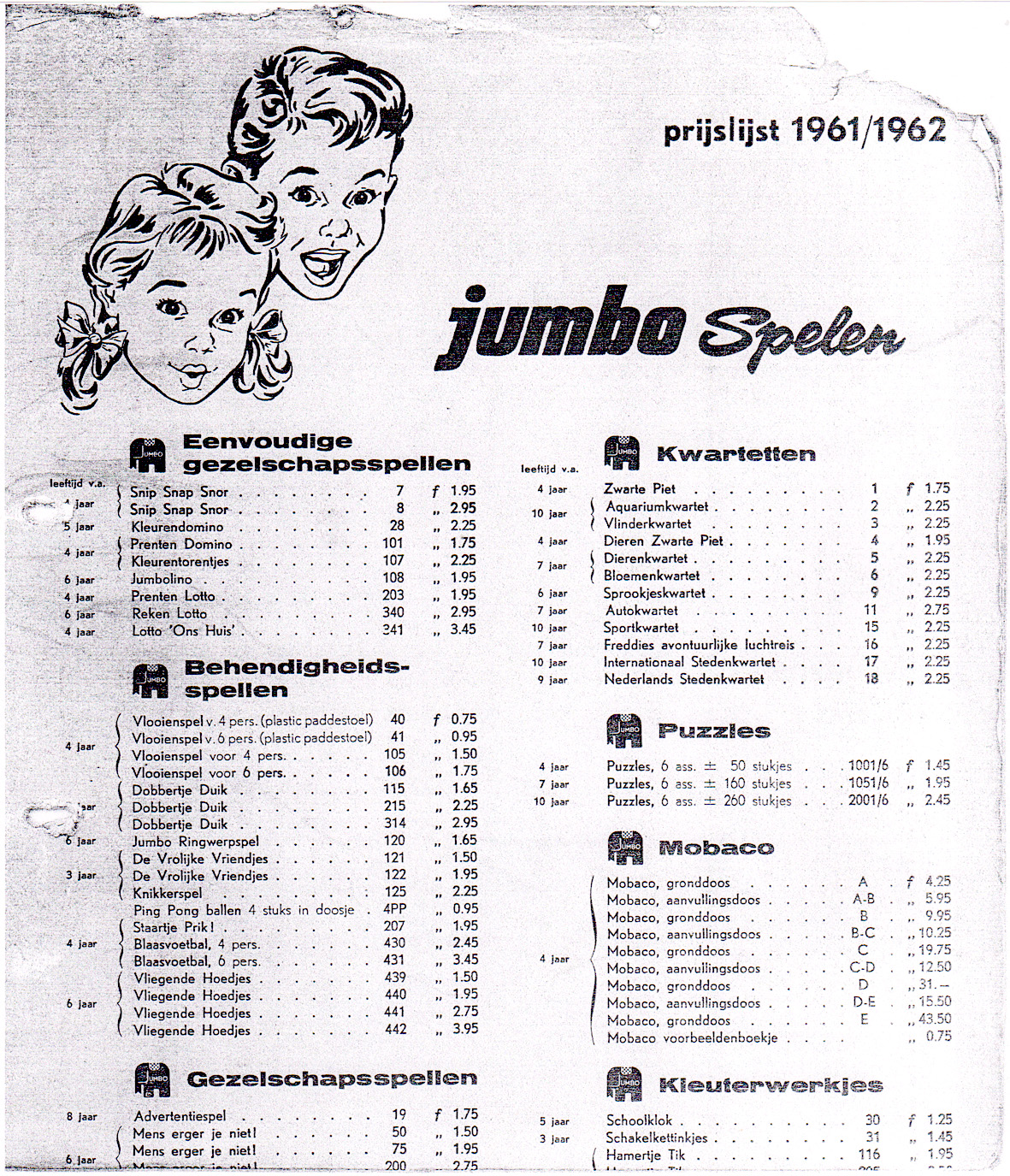 Various Jumbo advertisements Here a few Jumbo Mobaco ads with prices. They don't add new information about prices or chronology of sets, just fun to peruse.
In addition to buying complete sets, you could buy most Mobaco parts individually. Sometimes the store would have a dealer chest with parts, and otherwise they would order them for you. Moubal sold 97 spare parts. Parts 29 (clock face) and 89 (truss) disappeared in the 1937, 1938 and 1939 price lists, but were back in 1940. In 1949, Moubal started producing six new parts for Jumbo sets. Part 19 made it on the Moubal price list in 1950, while parts 1-1/2, 70, 71, 73 and 76 didn't make it on a Moubal price list until November 1952, Moubal's last price list. Jumbo sold 68 spare parts, leaving out many of the larger parts. Interestingly, they sold some spare parts which were not included in any of their sets. The prices of parts changed less frequently than of sets. As the bottom of the table below shows, there was a 39% price increase in 1937, then no increase for 13 years until 1950 when there was a whopping 139% price increase, followed by a 24% increase in 1951. Inexplicably, part 133 dropped in price in 1951 (highlighted in red). Some of the pricing doesn't seem to make sense. For instance, why would part 11, a simple rectangle, cost twice as much as part 13, a gothic window of the same size (1934). Prices on the first Jumbo list (striked through on the August 1953 price list, so from an earlier date) are identical to November 1952. But in 1953 prices were up 24% and by 1959 another 26%. Assembling a set by purchasing spare parts was an expensive proposition. For example, Set 0 in 1936 cost fl. 2.70, while the parts cost fl. 3.25 (without a box and a manual). However, in 1951, Set 0 cost fl. 10.75 while the parts cost fl. 10.73 (without the box and manual).  |
|||||||||||||||||||||||||||||||||||||||||||||||
| If
you have other price lists, please send me a scan (or even
a photo) for inclusion. I will credit your contribution
unless you don't want me to. |
|||||||||||||||||||||||||||||||||||||||||||||||